FOCUS FOR PEOPLE OVER 50
More
readers throughout Greater Washington


More
readers throughout Greater Washington

Whether we remember the taste of Grandma’s pies or the smell of Grandpa’s cigars, most of us recall our parents’ parents with fondness. After all, they seemed to love us unconditionally — and even spoiled us a little.
Some older adults in our area are stepping up to act as grandparents to children in need. And so far, they’re finding that the time they spend with children as “foster grandparents” gives them a new energy and sense of worth.
“We have something to give to young people. We have skills, experience and knowledge we can pass on,” said Charles Turner, who has been participating in a program called DC Grandparents for Mental Health since last fall. “It was my chance to give back,” he said.
Through the DC Grandparents for Mental Health program, the Washington-based global nonprofit HelpAge USA pairs adults 60 and older with children who can benefit from intergenerational conversations with trusted older people.

Through regular conversations in a church or school, the “grandparents” provide emotional support or simply a listening ear.
“Once you show them that you care about what’s happening with them, then you can maybe have some kind of positive impact,” Turner said.
Both age groups seem to benefit from talking with each other.
“Through this program, older people can give younger people a sense of connection, but they can also gain a sense of purpose,” said Cindy Cox-Roman, CEO of HelpAge USA.
“Older people have the highest rates of isolation, but younger people are twice as
likely to feel lonely…No one should be without someone to talk to.”
The need for volunteers in general has grown. According to a survey by the U.S. Census Bureau and AmeriCorps, volunteer participation dropped 7% between 2019 and 2021. The decrease, the most significant since these surveys began 21 years ago,
was likely the result of the pandemic.
“This is a wake-up call for the social sector, which depends on volunteers, especially as needs for services remain high,” said Michael D. Smith, CEO of AmeriCorps.
Foster grandparents can help out in just
See GRANDPARENTS, page 40
See a selection of floor plans to fit your budget and style. Call 1-877-575-0231 for your free brochure, or visit DMVSeniorLiving.com
LEISURE & TRAVEL
Time-travel to Maine to visit quaint drive-ins and candy shops from yesteryear; plus, cruise down the Mississippi River in style page 33

ARTS & STYLE
The world premiere at Arena Stage of the dramedy Exclusion runs through June 25; plus, nonfiction by local authors, and Bob Levey on what made 1968 unique page 39

FITNESS & HEALTH 4
k Unorthodox heart treatment
k Driving with memory loss
LIVING BOLDLY 24
k
for
k Banks now pay savers more
k How to write a better will ADVERTISER
Since the invention of microscopes and telescopes some four centuries ago, our view of the world around us and the universe in which we live has changed markedly.
What we used to believe about how our bodies worked, how stars and planets moved, and the very nature of reality have been repeatedly disrupted by new knowledge thanks to scientists and their steady improvement in developing technologies and experiments that uncover deeper and deeper layers of reality.
ly, but we no longer believe that what we see with our naked eyes is all there is.

Let’s start with what we see when we look at our own skin. We now know that a trillion or more bacteria live on each person’s body, feasting on the dead cells our skin constantly sloughs off. Even if they’re friendly, it’s a good thing we can’t see those little buggers, right?
 By Stuart P. Rosenthal
By Stuart P. Rosenthal
As a result, we have come to be more in awe of our own brainpower even as we lose (or should lose) some faith in our five senses.
We used to say “seeing is believing.” Perhaps we haven’t rejected that complete-
Speaking of what’s invisible to us, think about our old transistor radios and television sets, and today’s cell phones and Wi-Fi. The air all around us is filled with electromagnetic waves that are transmitting the sounds and images of millions of radio and television programs, streaming movies, personal calls and GPS instructions all at once.
Complete and return the Age-Friendly DC Survey found on the back page of this issue and you’ll be entered into a drawing for $250.
You can mail your survey, drop it off at any D.C. Library, or use this QR code to

Imagine what our lives would be like if our eyes could see such waves or our ears could pick up all those sounds. We would be unable to function!
Sometimes I think back to my seventhgrade science class. That’s where I first encountered the periodic table and learned that all matter — living or dead, organic or inorganic — is made up of atoms, and that those consist of protons, neutrons and electrons, all of which are in constant motion. It always made me wonder how anything can ever appear to be solid.
I find myself even today sometimes contemplating ordinary items in my daily experience — my desk, my car, a fly on the wall, this copy of the Beacon — and trying to imagine how they can all be composed of the same, constantly moving subatomic building blocks, only in different combinations.
Speaking of the periodic table, does it make sense that one additional proton distinguishes atoms of the metal lithium from those of the gas helium, or the gas nitrogen from carbon, or mercury from gold? How do so many characteristics of different forms of matter arise from such a seemingly small difference?
At the age of 12, I guess I took all this in stride, like just about everything else I learned in school. But the older I get, the more amazed I am by such facts — and by the many additional theories that physicists now use to explain what lies at the root of our daily reality.
By that, I mean much of what we were simplistically taught in grade school has been completely transformed by quantum physics and its ongoing discoveries. (These took a few decades to trickle down to school textbooks.)
derogatorily called “spooky action at a distance” has been proven: That when two quantum particles interact once, they continue to affect each other even when they are so far apart they can no longer have any way to communicate.
Oh, and by the way, did you know researchers have identified about 200 or so subatomic particles to date, thanks to experiments in the Large Hadron Collider at CERN?
Perhaps even deeper beneath these discoveries are so-called “strings,” which are hypothesized to be the vibrating energy underpinnings of subatomic particles, and hence of all nature.
One of my favorite lines from the theater is when the son Chris in Arthur Miller’s play All My Sons explains that he reads the book reviews in the newspaper because “I like to keep abreast of my ignorance.”
That’s how I feel about my occasional reading about contemporary science and the YouTube videos I often watch for the same reason.
Our understanding of the universe — like the universe itself apparently — is everexpanding and endlessly full of wonder.
I don’t pretend to really understand anything I’ve talked about in this column. But the more I learn (well, hear) about the many layers of what we call reality, the more I find myself agreeing with Trudy, Lily Tomlin’s character in Jane Wagner’s Search for Signs of Intelligent Life in the Universe, when she says, “Reality is the leading cause of stress amongst those in touch with it.”
The Beacon is a monthly newspaper dedicated to inform, serve, and entertain the citizens of the Greater Washington DC area, and is privately owned. Other editions serve Greater Baltimore and Howard County, Md. Readership exceeds 400,000.

Subscriptions are available via first-class mail ($36) or third-class mail ($12), prepaid with order. D.C. and Maryland residents: add 6 percent for sales tax. Send subscription order to the office listed below.
Publication of advertising contained herein does not necessarily constitute endorsement. Signed columns represent the opinions of the writers, and not necessarily the opinion of the publisher.

Publisher/Editor – Stuart P. Rosenthal

President/Associate Publisher – Judith K. Rosenthal


Executive Vice President – Gordon Hasenei
Managing Editor – Margaret Foster
Art Director – Kyle Gregory
Advertising Representatives –Dan Kelly, M.K. Phillips, Alan Spiegel
Marketing & Operations Manager – Ashley Griffin
Assistant Editor – Ana Preger Hart
Client Liaison – Jaclyn Thompson
Submissions:
www.theBeaconNewspapers.com
We now “know” that gravity is (probably) caused by the stretching of space-time, and that electrons don’t literally orbit nuclei, but are jumping around in “clouds” that surround them (but defy observation).
We are also told that what Einstein
Maybe I would amend that to say, “amongst those attempting to stay abreast of our understanding of it.” It’s challenging, mind-bending stuff. But it also continually fuels our sense of wonder and awe at the multi-level reality in which we live.
Dear Editor:
I was appalled when I read “The reasons low-fat diets disappeared” by Dr. LeWine in the April Beacon. While it’s true that low-fat merely leads to higher sugar and carbs, he is misinformed by stating that polyunsaturated fats are good and saturated fats are evil — in fact, just the opposite.
In 1993, McDonalds and most fast-food purveyors switched from beef tallow saturated fats to vegetable and seed oil polyunsaturated fats at USDA’s urging, and worldwide obesity has been a plague ever since.
The body does not benefit from ingesting the polys, which now inhabit most processed foods, and the result is that
“white fat” that hangs around your middle. Saturated fats, on the other hand, create “brown fat” that the body can utilize for energy when needed.
So why the push for polyunsaturated vegetable and seed oils? Simple — they are much cheaper and plentiful than beef tallow, lard, butter, palm oil or other saturated fats.
And, of course, the USDA is more beholden to Big Agriculture than to the health of American citizens — cynical, but true.
Polyunsaturated vegetable and seed oils, with their deadly omega-6 fatty acids, should be confined to biofuels and industrial

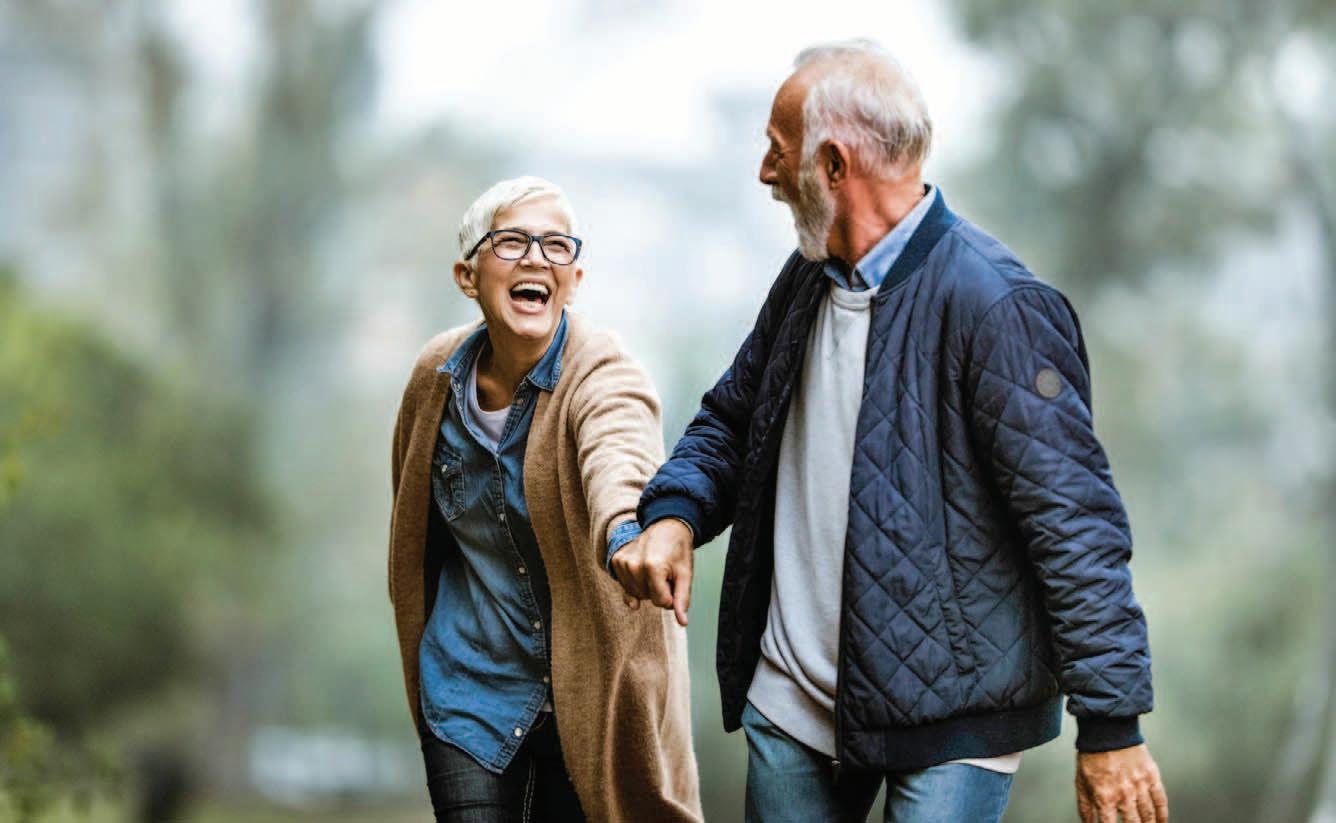

Set to open in spring 2024, The Carnegie at Washingtonian Center, a Kisco Signature community, epitomizes inspired and elevated retirement living that seamlessly blends urban sophistication with the beauty of nature. Th is exceptional community offers a unique lifestyle experience that allows residents to embrace the outdoors while enjoying the convenience and amenities of modern city living in the heart of Gaithersburg, adjacent to Malcolm King Park.
The Carnegie provides a serene environment where residents can escape the hustle and bustle of life and immerse themselves in nature. The lush green surroundings, mature trees, and well-maintained landscaping create a tranquil environment that sets the stage for an unparalleled outdoor living experience. “The Carnegie is truly an urban oasis in a park setting for gathering friends and family in the heart of Gaithersburg, Maryland,” explains Jen Wood, senior sales director for The Carnegie. “Malcolm King Park connects our residents with 72 acres of a natural wooded setting complete with creek beds, evergreen trees, sports courts – including pickleball and tennis – and nearly two miles of hiking trails connected to our backyard. Outdoor living will not only be an integral component of life at The Carnegie, it will be part of our wellness programming,” she adds.

Another highlight of The Carnegie is the beautifully designed courtyard, which serves as a centerpiece for the community. This meticulously landscaped area features comfortable reading nooks, cozy fire pits, and a variety of green spaces perfect for dog walks in the park, picnics with family and grandkids or outdoor yoga sessions. This terrace is also an ideal location for alfresco dining, one of many five-star dining experiences available on-site. The Carnegie's prime location also offers easy access to a wealth of outdoor activities and attractions. Within walking distance, residents can enjoy the unique blend of open-air shops, restaurants, and entertainment at nearby Downtown Crown or Rio Lakefront. A short drive away, Seneca Creek State Park is host to 50 miles of hiking, biking trails, fishing, and birdwatching, perfect to share with visiting grandkids. The Carnegie provides a best-of-both-worlds lifestyle – a peaceful retreat surrounded by nature, with the excitement of vibrant city living just steps away.
Through its Founding Members Program, The Carnegie offers a glimpse of what life will be like in this diverse and amenity-rich setting. Members enjoy community-oriented events and activities, all part of The Art of Living Well® programming, a multidimensional approach to health and wellness. Founding members can choose their preferred floorplans in advance and have a chance to form bonds with others who plan to call The Carnegie their home.
To experience The Carnegie lifestyle and learn more about becoming a Founding Member, schedule your personal tour of the two-bedroom model at The Carnegie Discovery Center: 129 Ellington Blvd in Downtown Crown | Call 240-213-7383 or visit lifeatthecarnegie.com

LOVE YOUR LIVER
Acetaminophen hides in many products; keep track of how much you take
Resisting the siren song of sugar can lead to better skin and a healthier heart
To avoid Lyme disease, cover up, spray clothes with repellant, and check for ticks
Tips for how to find a companion safely on a dating app or website
Doctors are zapping the heart with radiation normally reserved for cancer in a highly experimental bid to better treat people with life-threatening irregular heartbeats who’ve exhausted other options.
Surprising early research suggests the method may reprogram misfiring heart cells to control heartbeats more like younger, healthier cells do.
“It may actually rejuvenate sick tissue, and that’s pretty exciting,” said Dr. Stacey Rentschler of Washington University in St. Louis.
An irregular heartbeat called ventricular tachycardia is a major cause of sudden cardiac arrest, blamed for about 300,000 U.S. deaths a year. Treating it with radiation is a radical approach — cancer doctors are trained to avoid radiating the heart at all costs for fear of collateral damage.
Now researchers are about to begin the first rigorous study to prove if a quick, onetime dose to fight this irregular heartbeat works well enough — and is safe enough — for more patients like Jeff Backus, who
relapsed after standard care.
The Louisville man had already undergone an hours-long invasive procedure to keep his heart beating properly and had a defibrillator implanted as a backup.
Then this past winter, twice in about a month, Backus briefly passed out and awoke feeling like he’d been kicked in the chest. The defibrillator had to save him, shocking his heart back into rhythm.
“You’re always in the back of your mind thinking, ‘Is [another shock] going to happen?’” Backus said.
Out of other options to prevent another scary episode, he chose the experimental radiation in February — and so far, is doing well. “It gave me some hope.”
The heart’s electrical system normally makes it beat with a steady lub-DUB, anywhere from 60 to 100 times a minute.
Ventricular tachycardia is a super-fast heartbeat, unable to properly pump blood. It happens when those electrical signals short-circuit in the bottom chambers, the
ventricles, often because of damage from a prior heart attack.
The main treatment: Doctors thread catheters inside the heart to identify and burn the misfiring tissue, creating scars that block bad signals. Some patients are too sick for this “catheter ablation,” and for others, like Backus, the problem eventually returns.
Dr. Phillip Cuculich, a heart rhythm specialist at Washington University, came up with the idea for a no-incision alternative.
It takes a lot of up-front testing. Patients get a souped-up EKG, donning a vest covered in about 250 electrodes instead of the usual dozen to measure the heart’s electrical activity. Adding that to detailed medical scans gives Cuculich a three-dimensional map pinpointing where the heartbeat goes awry.
How to reach it? Cuculich teamed with Dr. Clifford Robinson, who specializes in precisely focused radiation to attack cancer while avoiding nearby healthy tissue.
Aiming at the heart “wasn’t on my radar at all. My goal was to miss the heart,” Robinson said. After all, some lung and
breast cancer survivors experience heart disease years later from tumor radiation that reached and inflamed heart tissue.
But he agreed to try, warning patients about possible long-term risks. His first arrhythmia patient responded, “You’re concerned about something that might happen 10 or 20 years from now? I’m worried about tomorrow,” Robinson recalled. “That was really eye-opening.”
Short procedure showed potential Patients lie in the same machine that normally blasts cancer, held in place and listening to music while customized beams hit just the right spot. It can take as little as 15 minutes.
Cuculich and Robinson reported the first successes in 2017 and 2019, experiments with small numbers of desperately ill patients who showed dramatic improvement. They say some are doing well up to six years later.
While the procedure is not approved by
See IRREGULAR BEATS, page 5
You’ve just seen your doctor, and you’ve been diagnosed with mild cognitive impairment or Alzheimer’s disease. Does that mean you shouldn’t be driving?
Driving is a complicated skill and a dangerous activity. Almost 43,000 people died in motor vehicle crashes in the U.S. in 2021.
In addition to good physical health, driving requires many brain systems to function together.
The thinking part of your brain consists of four pairs of lobes — occipital, temporal, parietal and frontal — in the left and right hemispheres of the brain, and all of them are active when you are driving.
Once you’ve learned to drive, most of your routine driving occurs automatically and unconsciously. This is why, if you become distracted while driving, you may find yourself heading to the grocery store on autopilot when you meant to go to the doctor’s office. Your conscious mind takes control, however, whenever the situation requires it.
Alzheimer’s disease and other forms of
dementia affect a variety of different brain regions, including all four lobes of the brain. For this reason, people with Alzheimer’s disease often show impaired visual, auditory, attention and decisionmaking abilities.
However, not everyone with Alzheimer’s must stop driving. It depends on both the overall severity of the disease, as well as the specific cognitive abilities that are impaired.
One study found that people with Alzheimer’s had an average of 0.09 car crashes per year, compared to 0.04 crashes in age-matched healthy adults. Another study found that individuals with early Alzheimer’s had impairments similar to 16to 20-year-old drivers.
So, on the one hand, people with Alzheimer’s are at increased risk while driving. On the other hand, when Alzheimer’s is very mild, accident rates are like those of new drivers — a group we as a society allow to drive with few or no restrictions.
Factors to consider
The American Academy of Neurology
has published guidelines to help clinicians know when individuals with Alzheimer’s and other dementias should stop driving.
The guidelines suggest that clinicians consider the following factors, as the risk of accidents increased when more of these factors were present:
• Do caregivers report marginal or unsafe driving skills?
• Is there a history of citations?
• Is there a history of crashes?
• Are they driving under 60 miles per week?
• Do they avoid driving in certain situations?
• Do they show aggression or impulsivity in their driving?
• Is their cognition impaired on standard testing?
• Is there evidence of other factors that can impair their driving, such as alcohol use, medications that cause cognitive impairment, sleep disorders, visual impairment or motor impairment?
My advice: If you have been diagnosed with a memory disorder, ask a family member (or close friend) to ride in the car
with you each month.
One of your adult children would be best. If your children feel comfortable with your driving, that usually means you’re driving safely.
Note that I am not concerned if you make a wrong turn or get lost. If you get lost, you can use a GPS or phone app or ask someone for directions.
I’m only concerned that you are a safe driver and are not endangering yourself or others on the road.
What if your family feels your driving is unsafe, but you believe you are a good driver? Take a driving test at your local registry of motor vehicles office or a rehabilitation hospital. That will allow you to prove to your family that you are a safe driver.
If you don’t pass the test, be courageous enough to hang up your keys. Take a taxi, use a rideshare app, or — even better — ride with a friend.
Andrew E. Budson, M.D., is a contributor to Harvard Health Publishing and an editorial advisory board member.
© 2023 Harvard University. Distributed by Tribune Content Agency, LLC.
From page 4
the Food and Drug Administration, the duo has since gotten permission to treat about 80 more people on a case-by-case basis.
And the St. Louis team has taught the technique to dozens of other hospitals in the U.S. and abroad that are cautiously trying it.
But the FDA requires stronger evidence for more routine use — and the more hospitals offer “off-label” radiation to these heart patients, the harder it will be to get that proof.
Now in an international study sponsored by device maker Varian, nearly 400 patients will be randomly assigned to either radiation or another catheter ablation to directly compare how they fare. Washington University just began recruiting potential participants; additional sites are set to open soon.
The bigger mystery: How the radiation prevents arrhythmias. Cuculich thought it would work by simply copying catheter ablation’s scarring, but was stunned when scans showed ‘’we weren’t actually causing a new scar — and that’s a big deal.”
BEACON BITS
June
Rentschler, a developmental biologist who also treats heart patients, took a closer look. Tests with donated human hearts and mouse hearts suggest the one-time moderate dose of radiation was prompting the misfiring cells to repair themselves.
In areas that got zapped, heart muscle cells temporarily switched on certain genes that normally are dormant in adulthood. Among them: a signaling pathway called “Notch” that helps a developing heart form its electrical system.
Reactivating that pathway “is perking up those areas” so they conduct electrical signals more like when they were younger, Rentschler explained. “We’ve never had any treatment that could do that.”
That’s very different than how repeat radiation doses can obliterate tumors. Now Rentschler’s research team is testing human heart cells in lab dishes, measuring exactly how they conduct electrical impulses — in hopes that even lower radiation doses might work.
“It’s really important that we get this right...that we figure out what the safe doses are and if there’s areas that we should be worried about,” Cuculich said.
© 2023 The Associated Press. All rights reserved.
SIGN UP FOR MD SENIOR OLYMPICS
Are you 50 or older? Then it’s time to sign up to participate in the Maryland Senior Olympics (and you don’t even have to reside in Maryland). Cycling and archery events are scheduled for June, while bowling, racquetball, shuffleboard and other events take place in August, September and October. First event costs $15 to $50; additional ones are $5 each. To register, visit mdseniorolympics.org.
SIGN UP FOR NOVA SENIOR OLYMPICS
July 6
Northern Virginia residents 50 and older can sign up for the Northern Virginia Senior Olympics starting July 6. Volunteers are needed to help with the events in September; email nvso1982@gmail.com. A registration fee of $20 covers unlimited event entries. To register, visit nvso.us.

to you!
• Dedicated team of Doctors, Nurse Practitioners and Physician Assistants
• Medication Management
• Mobile Radiology Services
• Mobile Laboratory Services
• Behavioral Health Management
Accepting Medicare & many other health insurance plans
301-450-5668
For free materials on housing communities and health studies, just complete and clip this coupon and mail, or take a picture and email it to the Beacon.
District of Columbia
❏ Chevy Chase House (See ad on page 22)
❏ Vida Senior Residences (See ad on page 19)
Maryland
❏ Brooke Grove Retirement Village (See ad on page 17)
❏ Cadence Living Olney (See ad on page 12)
❏ Carnegie at Washingtonian Center (See ad on page 3)
❏ Churchill Senior Living (See ad on page 22)
❏ Covenant Village (See ad on page 19)
❏ Emerson House (See ad on page 19)
❏ Grandview, The (See ad on page 6)
❏ HIP Home Sharing (See ad on page 45)
❏ Homecrest House (See ad on page 34)
❏ Homewood at Frederick (See ad on page 37)
❏ Leggett, The (See ad on page 21)
❏ Park View Bladensburg (See ad on page 36)
❏ Park View Columbia (See ad on page 36)

❏ Park View Emerson (See ad on page 36)
❏ Park View Laurel (See ad on page 36)
❏ Riderwood (See ads on pages 1, 6)

❏ Tribute at Black Hill (See ad on page 23)
Virginia
❏ Ashby Ponds (See ads on pages 1, 6)
❏ Chesterbrook Residences (See ad on page 14)
❏ Culpepper Garden (See ad on page 7)
❏ Falcons Landing (See ad on page 13)
❏ Greenspring (See ads on pages 1, 6)
❏ Lockwood House (See ad on page 19)
❏ Sommerset (See ad on page 18)
❏ Tribute at One Loudon (See ad on page 16)
❏ Tribute at the Glen (See ad on page 8)
❏ Westminster Canterbury at Chesapeake Bay (See ad on page 11)
❏ Woodleigh Chase (See ad on page 6)
❏ Cardiovascular Disease Research Study (See ad on page 23)


 By Howard LeWine, M.D.
By Howard LeWine, M.D.
Q: I take about four extra-strength Tylenol most days. Do I need to worry about my liver?
A: Acetaminophen, the active ingredient in Tylenol (and other brand names), is widely considered to be a very safe medication. For the vast majority of those taking it, acetaminophen appears to have no harmful effect on the liver or other parts of the body.
Still, your question is a good one because, although its safety record is quite good, too much acetaminophen — whether accidental or intentional — is a leading cause of liver failure requiring a transplant.
How can this be? One reason is that it’s easy to take too much. Acetaminophen is widely available without a prescription, and it’s contained in many combination medications — more than 600, according to one estimate — such as Nyquil, Excedrin and Midol.
It’s likely that many people taking acetaminophen do not realize they’re taking too much. For example, you might take acetaminophen tablets for the achy feeling that comes with a cold and also use a combination cough medicine that contains acetaminophen.
In addition, the reputation of acetaminophen as a safe drug may lead people to figure “more is better” and that a higher-thanrecommended dose won’t cause trouble.




The maximum recommended total dose of acetaminophen is 3,000 milligrams (mg) per day. Each extra-strength acetaminophen dose is 500 mg. So, that means no more than six extra-strength Tylenol over 24 hours, taking no more than two pills at a time.




But these recommendations apply to otherwise healthy people. Those who already have liver disease or risk factors for liver disease are generally advised to use acetaminophen sparingly in smaller doses or avoid it entirely.
People who drink more than moderate




amounts of alcohol or already have liver disease are more likely to develop liver damage from acetaminophen.
For example, a person with a hepatitis C infection may be prone to liver damage when taking doses of acetaminophen that might be harmless to others.
Risk is also higher for people who use combination acetaminophen-opiate products (such as Percocet). Increasing the dose of the opiate to control pain may provide too much acetaminophen.

Intentional overdose of acetaminophen in an attempted suicide can result in liver failure if the person doesn’t seek emergency care.


Acetaminophen is a good example of how almost any medication can cause serious side effects — just because it’s available over the counter doesn’t mean it can’t cause trouble. Read the label of any med-
ication you take and make sure you aren’t doubling up on acetaminophen.

Acetaminophen is safe and effective for most people who take it. Liver damage related to acetaminophen is highly preventable.
Howard LeWine, M.D., is an internist at













































Brigham and Women’s Hospital in Boston and assistant professor at Harvard Medical School. For additional consumer health information, see health.harvard.edu.
© 2023 Harvard University. Distributed by Tribune Content Agency, LLC.






 By Howard LeWine, M.D.
By Howard LeWine, M.D.
Q: I consider myself a healthy man. Do I really need a yearly physical exam?
A: While men often call it the yearly physical, the annual ritual is better named a wellness visit or preventive health appointment. Whatever you call it, men should still have one every year as it remains an important part of primary care.
For many men, this is one of the few extended opportunities for an in-depth conversation about their health. The meeting helps both the patient and the doctor address concerns, look at preventive measures, and create health goals and expectations together.
The traditional annual physical exam that focuses only on routine measurements and tests has drawn criticism in the past. Studies of the cookie-cutter model have suggested that it offers little value to peo-
ple and does not increase life expectancy.
For many men, the annual wellness visit is more than a snapshot of their current health. Over time, men need the chance to identify and reflect on what is important for their health and what goals they want to accomplish.





Without this regular interaction with their doctor, they can end up running around with no clear idea of where they are in terms of their overall health and the best ways to reach their new goals.
Today, doctors more often call the periodic visit to the doctor a “wellness visit” rather than a “regular check-up” or “yearly physical exam.” It can serve many purposes. During this visit, your doctor will want to:
• Ask if you have any new symptoms or health concerns
• Review your family medical history to see if you have a greater than average risk
for certain diseases, such as diabetes

• Review your medicines (both prescription and over-the-counter) and use of herbs and supplements










• Ask about health habits, including diet, exercise and use of tobacco and alcohol
• Perform a physical examination




• Administer vaccines or other preventive treatments



Also, this visit is chance for you to:
• Ask any questions that you might have


• Learn more ways to stay healthy
Does every adult male need a routine physical each year? Not necessarily.

Everyone should have their blood pressure checked every one to two years. I suggest a wellness visit every two years from ages 40-50. Once adults reach age 50, I recommend that they see their doctor once per year.
But don’t wait for a routine visit if you



have new symptoms. Call your doctor’s office for advice. Your doctor may not want you to wait for a regular check-up.
Q: I often notice slight swelling in both my ankles, but it is always gone in the morning. What causes it, and why would that start to happen?

A: It sounds like you have edema — swelling in your legs due to fluid in the soft tissues beneath your skin.
This usually occurs when pressure from the fluid inside your veins is high, which forces water out of the blood vessels and into the surrounding tissues.




The most common cause is leaky valves in your veins. Doctors call this venous insufficiency.





One-way valves in your veins help keep the blood flowing in the right direction. Ordinarily, as you walk around, your leg muscles squeeze the veins, which pumps the blood through these valves up toward the heart. When the muscles relax, the valves prevent blood from draining back down the vessels.

If these valves become leaky, the blood gets propelled upward, but much of it drops down again when the leg muscles relax. The result is an accumulation of blood — and an increase in pressure — within the veins. The higher pressure pushes fluid out of the veins, causing leg swelling.
It’s less likely that your edema is due to some other medical problem. But you should make an appointment with your doctor to be sure.
Your doctor will ask if you have shortness of breath, fatigue, or pain in your legs, and whether one leg is more swollen than the other.
Depending on your symptoms and your doctor’s physical exam, he or she might order blood and urine tests to evaluate your kidney and liver health. You might also need an echocardiogram to make sure your heart function is normal, or a leg ultrasound to look for blood clots.
Some medications can cause fluid retention in your legs. This can happen with high doses of ibuprofen (Advil, Motrin), naproxen (Aleve), and other nonsteroidal anti-inflammatory drugs.
Leg swelling is a common side effect of certain calcium-channel blockers, especially nifedipine (Procardia XL) and amlodipine (Norvasc).
To help minimize the swelling, raise your legs whenever you sit down. Even better, try to schedule 20 to 30 minutes during the day when you can lie down with some pillows under your feet to raise your legs above heart level.
You also might consider compression stockings. They help counter the pressure from within the veins and prevent fluid from seeping out of the blood vessels.
Usually, the knee-high versions are sufficient. It’s best to put on the stockings each morning before you get out of bed and then take them off at night.
© 2023 Harvard University. Distributed by Tribune Content Agency, LLC.

Primary Care Close To Home.
Holy Cross Health Partners, Progressive Medical Care
Holy Cross Health Partners, Kensington
Holy Cross Health Partners, Asbury Methodist Village

 By Matthew Perrone [Ed. Note:
By Matthew Perrone [Ed. Note:
Clostridium difficile (C. diff), is a bacterium that can cause life-threatening diarrhea, most often in patients 65 and over who have taken antibiotics. The infection is typically acquired in a hospital or nursing home setting, where the easily-spread infection is common, or from someone else who has the condition.]
U.S. health officials in April approved the first pill made from healthy bacteria found in human waste to fight dangerous gut infections — an easier way of performing so-called fecal transplants.
The new treatment from Seres Therapeutics provides a simpler, rigorously tested version of stool-based procedures that some medical specialists have used for

more than a decade to help patients.
The Food and Drug Administration cleared the capsules for adults 18 and older who face risks from repeat infections with Clostridium difficile (C. diff), a bacterium that can cause severe nausea, cramping and diarrhea.




C. diff is particularly dangerous when it reoccurs, leading to between 15,000 and 30,000 deaths per year. It can be killed with antibiotics, but they also destroy good bacteria that live in the gut, leaving the patient more susceptible to future infections.
The new capsules are approved for patients who have already received antibiotics.

More than 10 years ago, some doctors
began reporting success with fecal transplants — using stool from a healthy donor — to restore the gut’s healthy balance and prevent reinfections.
The FDA approved the first pharmaceutical-grade version of the treatment last year from a rival drugmaker, Ferring Pharmaceuticals. But that company’s product — like most of the original procedures — must be delivered via the rectum.
Both of the recent FDA approvals are the product of years of pharmaceutical industry research into the microbiome — the community of bacteria, viruses and fungi that live in the gut.
Currently, most fecal transplants are provided by a network of stool banks that have popped up at medical institutions and hospitals across the country.
While the availability of new FDA-approved options is expected to decrease demand for donations from stool banks, some plan to stay open.
OpenBiome, the largest stool bank in the U.S., said it will keep serving patients who aren’t eligible for the FDA-approved products, such as children and adults with treatment-resistant cases. It has supplied more than 65,000 stool samples for C. diff patients since 2013.

‘’OpenBiome is committed to maintaining safe access to ‘fecal transplantation’ for these patients as a vital last line of defense,” said Dr. Majdi Osman, the group’s medical chief.
OpenBiome’s standard stool treatment costs less than $1,700 and is typically delivered as a frozen solution within days of ordering.
Overseeing the fledgling industry of U.S. stool banks has created regulatory headaches for the FDA, which doesn’t traditionally police homemade products and
procedures used in doctor’s offices.
In the early days of the trend, the FDA warned consumers about the risks of potential infections from fecal transplants, as some people sought out questionable “do it yourself” methods from videos and websites.
Pill version costly, but simpler Cambridge, Massachusetts-based Seres will market its drug as a less invasive option than a transplant. The treatment will be sold under the brand name Vowst and comes as a regimen of four daily capsules taken for three consecutive days. It is expected to cost $17,500.
“We want to make the commercial experience for physicians and patients as easy as possible,” said Eric Shaff, the company’s chief executive officer, in an interview ahead of the announcement. “Ease of administration, in our view, is one of the aspects of the value we’re delivering.”
Seres will co-market the treatment with Swiss food giant Nestle, which will also split the profits. Seres will receive a $125 million milestone payment from Nestle in connection with the FDA approval.


Seres executives say their manufacturing process relies on the same techniques and equipment used to purify blood products and other biologic therapies.

The company starts with stool provided by a small group of donors who are screened for various health risks and conditions. Their stool is likewise tested for dozens of potential viruses, infections and parasites.
The company then processes the samples to remove the waste, isolate the healthy bacteria and kill any other lingering organisms. Thousands of capsules can

Kicking a sugar habit is challenging — even for the most strong-willed among us. Research has found that sugar tricks your brain into wanting more and more of it. But there’s good news: A little sweetness is OK. The American Heart Association recommends no more than 6 teaspoons of added sugar a day for women. Also OK: the sugar found in whole foods like fruits and veggies.
So, what are the benefits from reducing your sugar intake?
1. Younger-looking skin

The sugar in your diet affects the amount of sugar in your bloodstream, and studies suggest that high blood sugar levels can hinder the repair of your skin’s collagen — the protein that keeps it looking plump.
A diet full of treats can also reduce elas-
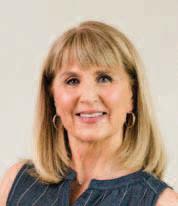

From page 10
be made from each stool sample, making it a more efficient process than current fecal transplants, according to the company.
The FDA warned in its approval announcement that the drug “may carry a risk of transmitting infectious agents. It is also possible for Vowst to contain food al-
ticity and cause premature wrinkles. Thankfully, research suggests that slashing your sugar intake can help lessen sagging and other visible signs of aging.
2. Lasting energy



Added sugars are simple carbohydrates. This means they’re digested fast and enter your bloodstream quickly, providing that familiar rush. But once that shot of sugar is metabolized, you’re in for a crash.
You may be riding this energy roller coaster all day, since added sugar is hiding in countless sneaky places — even salad dressing and barbecue sauce.

For a snack, try foods high in protein and healthy fat instead, such as a handful of almonds.
3. Bye-bye to abdominal fat
Everyone knows that a daily sugary soda habit can pack on the pounds. Sugary fare spikes your blood sugar, triggering a
lergens,” the agency noted.
The FDA approved the treatment based on a 180-patient study in which nearly 88% of patients taking the capsules did not experience reinfection after eight weeks, compared with 60% of those who received dummy pills.
Common side effects included abdominal swelling, constipation and diarrhea.
flood of insulin through your body, which over time encourages fat to accumulate around your middle.
These fat cells are the riskiest because they lead to inflammation that can contribute to conditions like heart disease and cancer. So, when you cut back on pop and desserts, you’ll start reducing belly fat and the dangerous conditions that come with it.
4. Drop extra pounds
Increased insulin levels don’t just add pounds to your stomach; they put fat cells all over your body into calorie-storage overdrive, according to endocrinologist David Ludwig, M.D., a professor of nutrition at the Harvard T.H. Chan School of Public Health, and co-author of Always Delicious
Replacing refined carbs and sugary
foods in your diet with healthy fats helps keep your insulin stable, he said, so fewer calories get stored as fat.
5. Reduce your diabetes risk
Since having fewer sweets helps you keep off excess pounds, you’ll also be more protected against Type 2 diabetes.
But eating less sugar also lowers your risk of the disease in another way: “A diet with lots of fast-digesting carbohydrates, like sugar, requires the pancreas to release lots of insulin, meal after meal, day after day,” Ludwig explained.
“That excessive demand may overtax insulin-producing cells, causing them to malfunction, eventually leading to diabetes.”
After a mild winter in the U.S., will there be an uptick in ticks this year?
Researchers say it is hard to predict how the tick season will play out. This year’s mild winter and early snow melt could mean more ticks earlier than usual, and a wider spread of Lyme disease and other tick-borne diseases, scientists said.
In Connecticut, ticks are showing up in greater numbers this year, according to Goudarz Molaei, a tick expert for the state. Since Jan. 1, more than 1,000 ticks have been sent in for a testing program, the second-highest number of submissions in recent years. The state typically sees a lot of Lyme disease, which got its name from a Connecticut town.
“It’s going to be an above-average year for tick activity and abundance,” Molaei said.


Infected ticks spread bacteria, viruses and parasites that make people sick.

Lyme disease is the most common tickborne infection in the U.S., mostly in the Northeast and Midwest. An estimated 476,000 Americans are diagnosed with Lyme disease each year, according to the Centers for Disease Control and Prevention.





Black-legged ticks, also called deer ticks, can carry more than Lyme-causing bacteria. They can also spread babesiosis, anaplasmosis and Powassan virus disease.
The lone star tick, mainly located in southern, eastern and midwestern states, can carry ehrlichiosis and Heartland virus disease.
American dog ticks can spread Rocky Mountain spotted fever. Ticks pick up disease-causing germs by biting infected wildlife, usually rodents.
It varies by region, but tick season generally stretches from April to October. Ticks are mostly dormant during the cold winter months and emerge as temperatures rise, but can be active on warm winter days, too.
Memorial Day is often considered the start of the season, but that’s largely because that’s when people in cold-weather states start spending more time outdoors, said Sam Telford of Tufts University’s School of Veterinary Medicine in North Grafton, Massachusetts.

Lyme disease cases typically peak in June, July and August.




Tiny ticks at the nymph stage — about the size of a poppy seed — are active in the spring, said Dr. Bobbi Pritt, who studies tick-borne diseases at the Mayo Clinic in Rochester, Minnesota. “When we have mild winters, we do anticipate that the











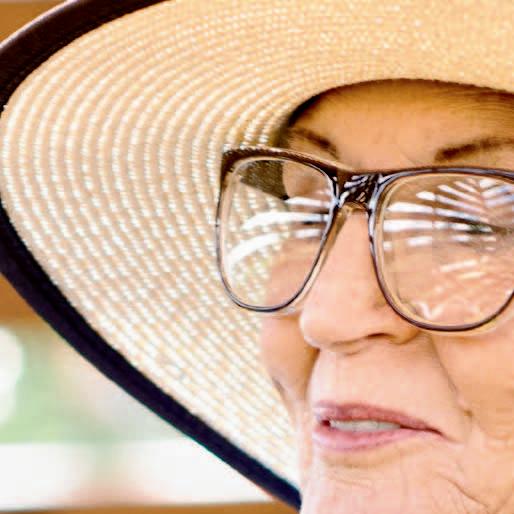

ticks are going to be out earlier and biting humans,” Pritt said.
Government disease trackers say predicting how tick-borne diseases will trend is complicated. The number of ticks can vary from region to region, and diagnoses can be affected by how well different doctors test and report cases.
The changing climate has both positive and negative implications for ticks, because warm, wet weather is beneficial to them, but especially hot weather is not, Telford said. Tiny ticks could indeed be active early, but a dry, hot summer could also kill ticks, he said.
The best approach is to assume that ticks will be very active. “Every year should be considered a bad tick year,” Telford said.
Thankfully, there are numerous ways to prevent tick bites. The CDC recommends treating clothing with products containing 0.5% permethrin.


It’s also important to be especially cautious in areas where ticks live, such as grassy and wooded areas. Using repellents and doing thorough checks afterward is also key, the CDC says. Limiting exposed skin also helps avoid bites.

The disease can cause a fever, chills, fatigue, and muscle and joint pain. It is treated with antibiotics, and most people recover.

Left untreated, it can worsen, causing symptoms such as heart problems and debilitating pain. There is no Lyme vaccine on the market in the U.S. for people, but one is being tested.




AP reporter Mike Stobbe and data journalist Camille Fassett contributed to this report.
© 2023 The Associated Press. All rights reserved.
From page 11



Good heart health helps you power through everything from intense spin classes to late-night work deadlines.

Research suggests that added sugar can take a real toll on the cardiovascular system. A 2014 study revealed that people who consumed 17% to 21% of their daily calories from the sweet stuff had a 38% higher risk of dying from heart disease compared with those who kept their added sugar intake to 8% of their daily calories.
The bottom line: Cutting back now will pay off big-time later.
Health delivers relevant information in clear, jargon-free language that puts health into context in people’s lives. Online at health.com.
© 2023 Dotdash Meredith. All rights reserved. Used with permission. Distributed by Tribune Content Agency, LLC.









a se with w our le c c e obsta th






T







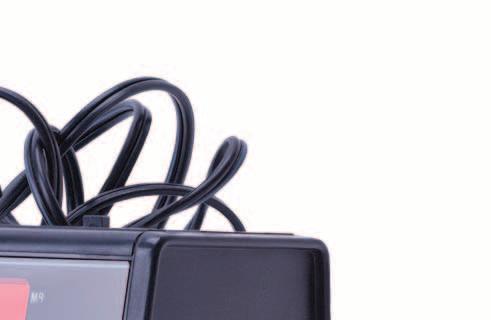









































































Dear Mayo Clinic: My mother had osteoporosis and suffered a devastating fall in her early 60s that she never recovered from.
I am 42, and I want to be proactive about my bone health. What screening do I need, and what, if any, supplements are necessary?

A: Osteoporosis is a condition that causes the bones to thin and lose their strength. When bones become weaker, sudden frac-
tures can occur, even with minimal trauma.


A calcium-rich diet is important to maintain optimal bone health and prevent osteoporosis. So, too, is vitamin D, which helps the body absorb calcium to be deposited into bones. The amount of calcium and vitamin D needed to optimize bone health increases with aging.
Circulating estrogen also is nurturing to bones. Consider the analogy that calcium and vitamin D are the bricks of the bone, and estrogen is like the mortar that holds

it all together.
While both men and women are at risk for developing osteoporosis as they age, women have a greater risk because they start to lose bone mass after menopause due to decreasing estrogen levels. Women can rapidly lose bone mass for up to 10 years after menopause begins.
Many factors contribute to bone loss and increase the risk of osteoporosis, including:
• Family history of osteoporosis or fractures related to osteoporosis.
• Nutrition, specifically inadequate calcium and vitamin D consumption.
• Smoking
• Body weight. A smaller, lighter body weight can increase the risk of decreasing bone mass.

• Exercise. A sedentary lifestyle will increase the risk of osteoporosis. Weight-bearing exercises like walking, jogging, tai chi and weightlifting can increase bone strength.
• Medication use. Certain medications can lead to thinning of bones with prolonged use.
• Racial differences. People of Asian and Caucasian descent are at higher risk, but African Americans tend to have more severe bone breaks.


Osteoporosis is typically detected using a bone mineral density test, which is quick and painless. This test is also known as a dual X-ray absorptiometry, or DXA, scan.
This test accurately measures the amount of calcium in bone and determines the density of bones, usually in the hip, spine, wrist or heel.
Your healthcare team can help determine when you would be eligible to start bone mineral density screening and how often screening should occur.

Menopausal hormone therapy also may be recommended for some women to defend their bones against rapid thinning. Also, several medications may be considered to stop ongoing loss or rebuild lost bone mass.
Regardless of whether you have already been diagnosed with osteoporosis, it is important to remember that a healthy lifestyle, exercise, a well-balanced diet, and optimal calcium and vitamin D levels can help prevent ongoing bone loss.

These are the daily recommended guidelines for calcium and vitamin D:
• Calcium. Those 50 and younger should strive for 1,000 milligrams daily. Those over 50 should aim for 1,200 milligrams daily.
• Vitamin D. Those 50 and younger should strive for 400–800 international units daily. Those over 50 should aim for 800–1,000 international units daily
Daily intake goals for calcium include the total amount of calcium from food or supplements combined.
As far as what to eat or drink to meet daily intake goals, consider these recommendations:
• Traditional dairy products, such as milk, yogurt and cheese. For example, one 8ounce serving of skim, low-fat or whole milk contains about 300 milligrams of calcium.
• Almond, cashew or oat milk
• Certain vegetables, including broccoli, kale and spinach
• Whole salmon [canned, with bones]
• Certain cereals, juices and breads with added calcium.
It can be difficult to consume the daily
Dear Savvy Senior, Can you recommend some good online dating apps or sites for retirees? I’m a 66-yearold widow and would like to find a new friend to spend time with, but don’t know where to turn.
Cautious Carol Dear Carol,
Whether you’re interested in dating again or just looking for a friend to spend time with, online dating sites and apps have become an easy and convenient way for older adults to meet new single people without ever having to leave home.
Some top mainstream sites/apps that are popular among older adults are eHarmony.com, Match.com and OKCupid.com.
If, however, you’re interested in sites geared specifically to older adults, some great options are OurTime.com or SilverSingles.com.
And to make things even easier, most sites today use matchmaking algorithms that factor in your interests and preferences so they can steer you to matches that are best suited for you.
Here are some tips to help you get started.
Choose a site: There are dozens of different matchmaking websites and apps available today, so choosing can be a bit confusing. While many sites offer free trials or watered-down free content, finding out the price can be difficult until you register and provide some information.
In general, viewing complete profiles and messaging potential dates will require a monthly fee, which can range anywhere between $10 and $40 per month.
From page 14
calcium requirement through diet alone. It’s best to take a supplement that makes up for what you don’t get in the diet.
But be careful not to exceed the daily allotment, as this may result in unwanted side effects.
When shopping for supplements, look for the United States Pharmacopeia (USP) seal or the word “purified” on the label. Most calcium supplements will need to be taken with food for better absorption.
Your gut can only absorb a limited amount of calcium at one time — 500-600 milligrams or less. So it is important to spread your calcium consumption throughout the day.
When exposed to sunlight, your skin can make vitamin D, but amounts vary based on climate, skin pigmentation, age, season and more.
Few foods contain vitamin D, but common sources include wild-caught fish, such as salmon, mackerel and tuna, as well as dairy products, juices and fortified cereals.
It is difficult to meet vitamin D requirements with food and sunlight alone. Most people will need to take a daily vitamin D supplement.
© 2023 Mayo Foundation for Medical Education and Research. All rights reserved. Distributed by Tribune Content Agency, LLC.
Or if you have a specific kind of person you’d like to meet, there are dozens of niche sites like: EliteSingles.com for educated professionals, ChristianMingle.com for Christian singles, BLK-app.com for black singles, JSwipeApp.com for Jewish singles, and Facebook.com/dating for people who love Facebook.
Create a profile: When you join a matchmaking site, you’ll need to create a
personality profile that reflects who you are, including recent photos, hobbies, interests, favorite activities and more. If you need some help, sites like ProfileHelper.com can write one for you for a fee.
Practice caution: When you register with a site, you remain anonymous. No one gets access to your personal contact information until you decide to give it out, so be prudent with whom you share it.

Before setting up a meeting, you should chat on the phone or video chat a few times, and when you do meet in person for the first time, meet in a public place or bring a friend along.
And if someone asks for money or your financial information, don’t give it out. Online dating/sweetheart scams are rampant, so be very cautious.
Be skeptical: In an effort to get more responses, many people will exaggerate or flat



out lie in their profiles, or post pictures that are 10 years old or 20 pounds lighter. So, don’t believe everything you see or read.
Make an effort: A lot of times, people — especially women — sit back and let others come to them. Don’t be afraid to make the first move. When you find someone you like, send a short note that says, “I really enjoyed your profile. I think we have some things in common.” Keep it simple.
Don’t get discouraged: If you don’t get a response from someone, don’t let it bother you. Just move on. There are many others that will be interested in you, and it only takes one person to make online dating worthwhile.
Send your senior questions to: Savvy Senior, P.O. Box 5443, Norman, OK 73070, or visit SavvySenior.org. Jim Miller is a contributor to the NBC Today show and author of The Savvy Senior book.

Hurricane & rainy season is coming , and that means our area.
 By University Health News
By University Health News







Mushrooms have been consumed and used for medicinal purposes for thousands of years.
The ancient Greeks believed mushrooms provided strength for warriors in battle, and the Romans perceived them as “food of the gods.”
For centuries, Chinese culture has treasured mushrooms as a health food, labeling them an “elixir of life.” Traditional Chinese medicine continues to highly
value mushrooms, believing they offer numerous health benefits and play a role in preventing and treating various ailments.
Although more than 2,000 varieties of mushrooms are edible, the most common variety grown in the United States is white button, followed by crimini, portobello, enoki, oyster, maitake and shiitake.
Mushrooms grow in nearly every state; however, Pennsylvania accounts for approximately 60% of total mushroom production in the United States.
Key nutrients found in mushrooms include B vitamins, selenium, copper, potassium, beta-glucans, and the powerful antioxidants glutathione and ergothioneine.
Sharon Palmer, MSFS, RDN, who calls herself the plant-powered dietitian, notes that “the selenium found in mushrooms is unique in produce. The main intake of this antioxidant nutrient is most often from meats, dairies and whole grains.”


The ability to produce vitamin D when exposed to the sun is also a distinctive attribute of mushrooms. “They can create vitamin D in a similar way humans can with sun exposure,” Palmer said.


Interestingly, consumers can increase the vitamin D in mushrooms by exposing them to sunlight before eating. A preliminary trial demonstrated that vitamin D in mushrooms can be increased by at least 25% of the Dietary Reference Intake by exposure to sunlight for as little as 15 minutes.
Mushrooms also provide fiber and protein, and can be particularly useful for vegetarian diets, considering they provide all the essential amino acids and have higher protein content than most vegetables.
Mushrooms are reported to have antimicrobial, anti-inflammatory, cardiovascular-protective, antidiabetic, hepatoprotective and anticancer properties.
According to Palmer, they contain “bacteria, yeasts and molds that appear to have health potential. Studies show that mushrooms are linked to anticancer activity, antioxidant action and immune-enhancing benefits. They have also been shown to have benefits for blood lipids and glucose.”
Robert Beelman, director of the Penn State Center for Plant and Mushroom





Products for Health, has been investigating possible anti-aging benefits of mushrooms.




He and his team found mushrooms have high amounts of ergothioneine and glutathione. This may protect against oxidative stress, which has been associated with diseases of aging, cancer, coronary heart disease and Alzheimer’s.


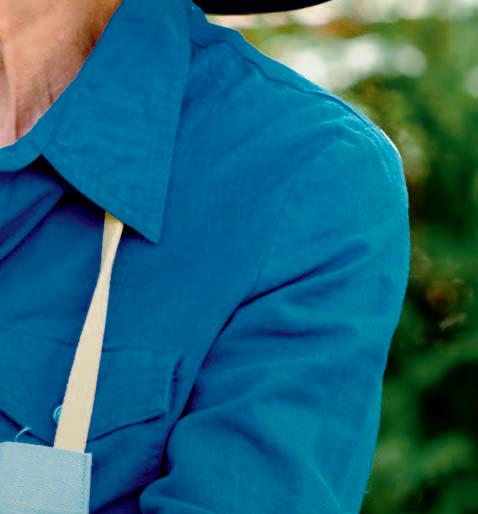


Beelman points out that “countries that have more ergothioneine in their diets, like France and Italy, have lower incidences of neurodegenerative diseases, while people in countries like the United States, which has low amounts of ergothioneine in the diet, have a higher probability of diseases like Parkinson’s and Alzheimer’s.” Whether this is a correlation or causation is unclear.
The health benefits of mushrooms vary by species. Beelman and team found the highest amounts of ergothioneine and glutathione in porcini mushrooms. The more common mushroom types, like white button, had fewer antioxidants.

Animal studies have reported that shitake mushrooms have antitumor, cholesterollowering and antiviral properties. Enoki mushrooms appear to have significant anticancer and immune-enhancing effects.
Maitake may have anticancer, antiviral, immune-enhancing properties, and may also reduce blood pressure and blood sugar levels.
Beelman recommends trying to consume approximately three ounces of button mushrooms or one ounce of specialty mushrooms (shiitake, oyster or maitake) daily. Cooking does not appear to significantly affect the compounds in mushrooms.
ate E


E a trehabilit ar he t -








y of L al alit it he v t eju e r ienc Exper -of

























































ook t Br a LIFE®
ional indepen Except




























































Dedic
ad g he in uvenat l
oo






















yDi y Simp
ss ellne oe w t to- d- lne t







t hatinspiresa iont t
ire et e R ov e Gr k
g in an e in ndent liv
•Ex freedo because ...
ace s and embr ement V men
ic and suppor nerget fferent
illage. i
y • ommunit e c iv t r
ssist andrestores•A



















-discov - e and se hoic


e an iv vat y • Inno er s A and r
an e • Me ar g c ursin
in ssio ompa ed and c at c illed n k ional s xcept h , c vement om of mo t r of us rrou t su t h e w




































aff c t e s onat
s a t ins ion t lf a y ou o u
u t hatnu ingt edliv
ures
enr ® nin

t nu g t ed liv af ma
y sup e memor nd s
amming og
nds y reall al tters. t
IFE® g • t ppor ww
There’s more to weight loss than simply watching calories. In fact, several studies have suggested that the time when you eat meals has a big impact on weight-loss success. So, what are those optimal times? That would likely differ by individual, but there are some general recommendations you can follow.
Dinner: The overall consensus among health professionals and researchers is that it’s best to eat dinner early (at least


June 15
two to three hours before bed) and then close the kitchen for the night. This deters late-night snacking and allows the body to burn some calories before bed.
It also gives the body time for digestion. When you go to bed on a full stomach, you’re less likely to get adequate, goodquality sleep, which triggers hormonal changes that can deter weight loss.
Additionally, our circadian rhythms enable the body to more efficiently burn calories, control blood glucose and optimize di-
Do you know the signs of elder abuse? Learn more at this free World Elder Abuse Awareness Day event, both live and over livestream. Watch videos of senior safety skits and participate in a Q&A with experts at 10 a.m. on Thurs., June 15 at the Holiday Park Senior Center, 3950 Ferrara Dr., Silver Spring, MD. Free music performances and yoga sessions will be available. To register, visit WEAAD2023mc.eventbrite.com.
June 29
Want to keep your cognitive skills sharp? Tune in for a free interactive discussion led by Dr. Steven Simmons, internist at MedStar Health, and Jodi L. Lyons, Chief Care Officer of CareBrains, co-authors of Brain Health as You Age: A Practical Guide to Maintenance and Prevention. The event takes place on Zoom at noon on June 29. To register, visit bit.ly/June29brainhealth.
gestion earlier in the day. This means eating dinner at 5 p.m. instead of 8 p.m. could potentially impact weight loss by aligning closer to the body’s internal clock.
An early dinner also increases the block of time we go without food, which increases fat-burning and improves the regulation of hormones that impact appetite, cravings and blood sugar.
Lunch: The timing of lunch appears to have the least impact on weight loss, but what is notable about lunch is that it should be your biggest meal (along with breakfast if consumed).
This goes back to those circadian rhythms driving the body’s increased efficiency earlier in the day.
Breakfast: Instead of asking what time to eat breakfast, the more popular question is: Should you eat breakfast if you’re trying to lose weight?
Technically, all of us “fast” each night while asleep. You can successfully lose weight whether you’re a regular breakfast eater or an intermittent faster who skips breakfast.
First, make sure you get at least a 12-hour break between dinner and the next meal. Second, regardless of whether you eat your first meal at 7 a.m. or 11 a.m., try to make that first meal substantial and nutrient-dense.
1. Eat breakfast, but not necessarily in
From page 16
For those who do not like the taste or texture of mushrooms, their nutritional and health benefits can be obtained with mushroom powders found in stores. Palmer emphasizes it is important that the
the morning. “Breakfast” technically refers to when you break your fast from the previous day, and there is no specific time that should occur.
2. Prioritize eating during the first half of the day. Aim to consume the majority of your calories and nutrients by mid-afternoon. For one person, this may mean eating breakfast, lunch and two snacks. For another, it may mean eating a large brunch meal and one snack.
3. Make dinner early and light. You may even consider eating as early as 4 or 5 p.m. If this isn’t possible, try eating dinner at least three or more hours before bed.
4. Go 12 hours between dinner and your next meal to reap benefits that facilitate weight loss, fat burning, metabolism and management of appetite and cravings. Healthy individuals may consider fasting longer (13 to 16 hours).
While often beneficial to the health of all individuals, those with a chronic health condition such as diabetes should consult with their healthcare provider, particularly if this period without eating is significantly different from their current eating times.
EatingWell is a magazine and website devoted to healthy eating as a way of life. Online at eatingwell.com.

© 2023 Dotdash Meredith. All rights reserved. Used with permission. Distributed by Tribune Content Agency, LLC.
powder or supplement comes from whole mushrooms.
Reprinted with permission from Environmental Nutrition, a monthly publication of Belvoir Media Group, LLC, 1-800829-5384, EnvironmentalNutrition.com.

© 2023 Belvoir Media. Distributed by Tribune Content Agency, LLC.


Matcha and coffee are popular beverages known for their health benefits and energy-boosting properties. While they both contain caffeine, they differ in taste, nutrient composition and effects on the body.
Matcha is made from finely ground shade-grown green tea leaves. The shade-growing process increases chlorophyll and L-theanine content, giving matcha a vibrant green color and unique umami flavor.

Matcha contains higher levels of antioxidants, amino acids and caffeine than green tea, as the entire leaf is consumed. You’re literally drinking crushed-up leaves when you have matcha.
for it because it’s rich in antioxidants, essential nutrients and caffeine. Coffee beans are roasted, which gives them that characteristic flavor and aroma.
Caffeine levels differ



Caffeine in both matcha and coffee can enhance alertness, cognitive function and memory.

fiber from ground tea leaves.
Matcha has been an integral part of Japanese tea ceremonies for centuries. The Chada ceremony is a highly ritualized practice that involves serving matcha tea in a serene and meditative setting, emphasizing harmony, respect and tranquility.
In summary, matcha and coffee each offer unique health benefits and flavors. I drink both every day.
By Suzy Cohen
Coffee, on the other hand, comes from the seeds of the Coffea plant. It lacks Ltheanine and chlorophyll, but makes up


Matcha has less caffeine than coffee, but its effects can last longer due to the synergistic action of L-theanine. The calming properties of L-theanine can balance the stimulant effects of caffeine, providing a focused and sustained energy boost.

Both drinks may have a laxative effect, with coffee generally producing a stronger effect. Matcha has a milder impact, primarily due to its lower caffeine and dietary
Japanese tradition of “forest bathing” is a relaxing form of meditation. Learn the ropes and try it out at Long Branch Nature Park, 625 S Carlin Springs Rd., Arlington, VA. Meet there on Sat., June 10 at 10 a.m. Register and pre-pay the $10 fee at Arlingtonva.us or call (703) 228-6535.
Traveling with matcha packets is convenient due to their compact size and versatility. Matcha can be easily mixed with hot water or added to smoothies, lattes or baked goods. I made my own matcha drink at the coffee station at my hotel just last week.
Coffee packets are also portable, but when traveling, you can almost always find a coffee machine nearby, not to mention a Starbucks.
Incorporating them into your routine can provide an enjoyable way to boost wellbeing and cognitive performance. Choose the beverage that best suits your taste and preferences, or consider combining the benefits of both by alternating or mixing them in creative ways.
This information is opinion only. It is not intended to treat, cure or diagnose your condition. Consult with your doctor before using any new drug or supplement.



Suzy Cohen is a registered pharmacist and author of The 24-Hour Pharmacist and Real Solutions from Head to Toe



When you need help, rather than going to rehab or assisted living, it’s comforting to know there’s a way to bring qualifi ed help safely to your home.


Q: Is it possible to make yourself a happier person?
A: Yes, the burgeoning field of positive psychology has identified ways to help us





June 16
find happiness — by learning to appreciate the goodness in everyday life and to find joy through expressing gratitude and helping others.
Here are five ways to add more happi-
A huge pop-up bookstore will be open for business on Fri., June 16 and Sat., June 17 at the Woodrow Wilson Plaza in downtown D.C. All books, records, CDs and DVDs are on sale for $6 or less. The free outdoor event will be held at the Ronald Reagan Building and International Trade Center, 1300 Pennsylvania Avenue, NW, Washington, DC.

June 24
Join the Seneca Valley Sugarloafers Volksmarch Club for a handicapped-accessible hike on the Matthew Henson Trail, named after the African American co-discoverer of the North Pole. The walk starts anytime between 8 and 11 a.m. on June 24. Start and finish at the Mid-County Community Recreation Center, 2004 Queensguard Rd., Silver Spring, MD. Cost is $3. For more information, call Darla Fera (301) 649-2601 or visit sugarloafers.org.

ness to your life:
1. Smile at the first 10 people of the day.
Why? Smiling is contagious, and it may make you happier, too, as people tend to mirror the expressions of those they’re looking at.
What to do: Smile at the first 10 people you see. They’re likely to smile back. Plus, the positive feedback loop might make your morning happier.
Try this for a week. Observe how you feel when smiling and during the rest of your day.
2. Give thanks.
In research, gratitude is strongly and consistently associated with greater joy and happiness.
Most of us have a lot to be thankful for if we just stop and think about it. Shining a spotlight on the goodness in your life allows you to truly relish positive experiences.
What to do: Every day, write down three things for which you feel thankful. Be specific, and relive the sensations you felt as you remember what each gift means to you.
3. Seek out happy people.
According to research published in the journal BMJ, people surrounded by happy people are more likely to become happy in the future. For example, a person who became happy boosted a friend’s probability
of happiness by 25%.
What to do: Revel in the company of happy souls. In fact, it may be worth seeking out happy people through activities you enjoy, a religious community that resonates with you, and volunteer opportunities.
4. Volunteer.

Helping other people kindles happiness, as many studies have demonstrated. According to a study in Social Science & Medicine, the more people volunteered, the happier they were.
What to do: Volunteer at a senior center, park, school, religious organization or political group you appreciate.

5. Find the flow.
Have you ever been so immersed in what you were doing that distractions and background chatter just fell away?
Dubbed “flow,” this state of being feels effortless yet active. You lose awareness of time; you cease to think about yourself or feel distracted by extraneous thoughts.
What to do: Think about times in your life when you’ve experienced flow, and seek a new way to invite it into your life.
Match your skills to a new activity that offers rich sensory experiences — perhaps a pottery class, a carpentry project or a different art medium.
© 2023 Harvard University. Distributed by Tribune Content Agency, LLC.

When


andBra tme Apar dNew
enio S
xce an e iscoveD
t w home a our ne er y

elco o w t commu
, eggett he L T , MD , r Spring
eptional senior hous
e w op t is no y tha unit
eady en and r sing
er ors 62+ in Silv d New o e thrilled t ar











e a W ts. esiden ome r

• eatingElevatorS PetSpa

ea w r ounge A Relaxing L
y ntr ess E cc olled A Contr
errac e top S ounge with P ResidentL tunning Roof T Storage

V T creen door S ut e with O c reas ting A ea Plush S ush Roof












arden op G t with a L

e S ik age & B ar ing G Park
omo edr -b wo ell as t
e-b y in our **one ilit owever . H ully leased
edib incr
tm apar availab een fu b den as w announ Vis y! tunit oropp ble t miss o ' , so don ents








ed -b t our one e tha nc y! da o out on this omo dr ve e still ha , w ve m units ha om and or r sit T






e C c enior Resour and a S
ro oly C y H ed b at e oper b
ounty outh C AccesstheS or S e t F tmen Apar
ospital. oss H y acilit e F ar y C Center/Primar

















• Tiled wallFully Wallto asher and D W In-Home





person, ncome I
t will y tha uaticCenter t homes c

eg he L T w is t No . guidelines may apply
o M inimum $44 ange: M r

ome g **Inc
t ot a our sp
o























ggett! e y o secur the time t aximum $91,120 f o persons w ort




















•
yer r




• • • • • • t tE t lA K Thermo Programmable abi y C eightPantr ull H F
qu tion and A ea Regional Recr eatures * In selec Shelf

teelApplian tainless S S alcony* e B Privat losets* -in C Walk









arpeting looring and C ars + S ab B er with G d Sho





ars+SdShowerwithGrabB

ood Plank F W eautiful B all F -w all-t on e C limat om C ust or C o osta net* er e Mak c age with I cePack














t f ntrol
• n t E tmen par eyless A y r


Who knew one sheet pan could provide so much depth in flavor in one dish?
For this recipe, before you get everything together on the pan, start with the marinade in a blender. The marinade features refreshing mint, herby oregano and pungent garlic.
It also gets a subtle earthiness from cumin and smoked paprika, plus a little kick from half a habanero chile, and brightness from lime zest and juice.
For the sides, roasted sweet potatoes fit the dish’s Peruvian profile nicely, and roasted cauliflower adds a deep, nutty complexity.
Giving all the vegetables a head start in the oven means they can brown on the un-
crowded sheet and then roast to perfection with the chicken.
Tossing the vegetables and accumulated chicken juices with peppery arugula while the chicken rests adds a fresh flavor to complete the dish.
One-Pan Peruvian Chicken with Cauliflower and Sweet Potatoes
Serves 4
Note: You can substitute 1 tablespoon of minced serrano chile for the habanero, if desired. Wear gloves when handling the chile.
Ingredients:



6 tablespoons extra-virgin olive oil, divided
¼ cup fresh mint leaves

6 garlic cloves, peeled
3½ teaspoons pepper, divided
1 tablespoon ground cumin
1 tablespoon sugar
2 teaspoons grated lime zest plus ¼ cup juice (2 limes)
2 teaspoons table salt, divided

2 teaspoons smoked paprika
2 teaspoons dried oregano
½ habanero chile, stemmed and seeded
4 (10-ounce) chicken leg quarters, trimmed
1 small head cauliflower (1½ pounds), cored and cut into 1½-inch florets
1 pound sweet potatoes, peeled and cut into 1-inch pieces
1 small red onion, halved and sliced through root end into ½-inch-thick wedges
3 cups (3 ounces) baby arugula
Directions:



1. Process 3 tablespoons oil with mint, garlic, 1 tablespoon each pepper, cumin, sugar, and lime zest and juice, 1½ teaspoons salt, 2 teaspoons paprika and oregano, and the habanero in blender until smooth, 10 to 20 seconds. Transfer marinade to a 1-gallon zipper-lock bag. Add chicken, seal bag, and turn to coat chicken with marinade. Refrigerate for at least 1 hour or up to 12 hours.
2. Adjust oven rack to middle position and heat oven to 425 degrees. Combine remaining 3 tablespoons oil, remaining ½ teaspoon pepper, and remaining ½ tea-




spoon salt on a rimmed baking sheet and toss with cauliflower, potatoes and onion. Spread into an even layer. Bake until the top edges of the cauliflower and potatoes are lightly browned, about 15 minutes.
3. Remove sheet from oven. Using a spatula, push vegetables to 1 side of the sheet (they will no longer fit in a single layer). Place chicken, skin side up, on the now-empty side of the sheet. Roast until chicken registers 175 degrees and vegetables are tender, about 40 minutes, rotating sheet halfway through.
4. Transfer chicken to a carving board and let rest for 10 minutes. Add arugula to the sheet with vegetables and gently toss to combine. Transfer vegetable mixture to platter. Separate leg quarters into thighs and drumsticks, then transfer to a platter with vegetable mixture. Serve.
For 25 years, home cooks have relied on America’s Test Kitchen for rigorously tested recipes developed by professional test cooks and vetted by 60,000 at-home recipe testers. The family of brands — which includes Cook’s Illustrated, Cook’s Country and America’s Test Kitchen Kids — offers reliable recipes for cooks of all ages and skill levels. See more online at americastestkitchen.com/TCA.
© 2023 America’s Test Kitchen. Distributed by Tribune Content Agency, LLC.









“Listen Live at the Lincoln,” a free concert series by The U.S. Army Band, will take place on the East Steps of the Lincoln Memorial on Saturday nights this summer. No tickets required. Concerts will begin at 8 p.m. on Sat., June 10, July 15, July 22, July 29, Aug. 5 and Aug. 12. For more information, visit usarmyband.com/concert-series/listen-live-at-the-lincoln.







 By Margaret Foster
By Margaret Foster
Older adults have a lot of vaccine requirements: a seasonal flu shot, a series of shingles shots, and now a COVID-19 booster, too.
To streamline the vaccination process, Pfizer and BioNTech have developed a single dose, mRNA-based combination vaccine that protects against both seasonal influenza and Covid. The drug companies are testing the vaccine candidate now in a phase 1 study.

Sponsored by BioNTech, the randomized study last fall began enrolling 180 adults ages 18 to 64. Researchers will follow up with participants for six months.
The study is designed to evaluate the dual vaccine candidate’s safety, tolerability, and ability to provoke an immune response.
From page 2
lubricants — not for human consumption.
 David B. Swink Vienna, VA
David B. Swink Vienna, VA
BioNTech pointed out that the two-atonce approach can protect more people.
“By combining both indications in one vaccine approach, we aim to provide individuals with an efficient way to receive immunization against two severe respiratory diseases with evolving viruses that require vaccine adaptation,” Prof. Ugur Sahin, M.D., CEO and co-founder of BioNTech, said in a statement.
The shot “combines Pfizer’s quadrivalent mRNA-based influenza vaccine candidate with the companies’ Omicron-adapted bivalent COVID-19 vaccine,” according to a statement from both companies.
Messenger ribonucleic acid (mRNA) technology was effective in developing the original Covid vaccine.
damaging effect on the environment. People must learn to reduce wasteful consumption, before it is too late.
“The flexibility and manufacturing speed of the mRNA technology has demonstrated that it is well-suited for other respiratory diseases,” said Annaliesa Anderson, Ph.D., Pfizer’s senior vice president and chief scientific officer of vaccine research and Development.
According to the companies’ statement, this is the fourth time Pfizer and BioNTech have collaborated. They first worked together in the infectious diseases field in 2018 on a flu vaccine. Then, in 2020, they collaborated on a Covid vaccine. Last year

they began working together on a shingles vaccine.

Members of the public can report vaccine side effects to the U.S. Food and Drug Administration (FDA) and the Centers for Disease Control and Prevention (CDC) Vaccine Adverse Event Reporting System (VAERS). The VAERS toll-free number is 1800-822-7967 or you can report side effects online at vaers.hhs.gov/reportevent.html.
In addition, individuals can report side effects to Pfizer Inc. at pfizersafetyreporting.com or by calling 1-800-438-1985.
Dear Editor:
In the publisher’s column on funding of Social Security in the April issue, he has red flagged a very serious issue and rightly cautioned to mend it before it is too late.
However, I would like to add another perspective to this crucial issue. With the advances in automation technology, the output of a worker has multiplied many times over and is going to get further multiplied with future advances in robotic and AI technology.
However, the real problem is excessive consumption and consequent irreversible





Also, medical care must be rationalized. The spectacular advances in medicine have prolonged the life span but not done much to improve the quality of life.
The government must prioritize preventive healthcare over curative medical care.
Preventive healthcare includes promoting nutritious food habits, spreading awareness about healthy lifestyles, providing conveniently accessible gym facilities and more.
The aim of healthcare should be to reduce the number of people falling sick or needing caregiving. This shift in approach can save money and also improve the quality of life of senior citizens.
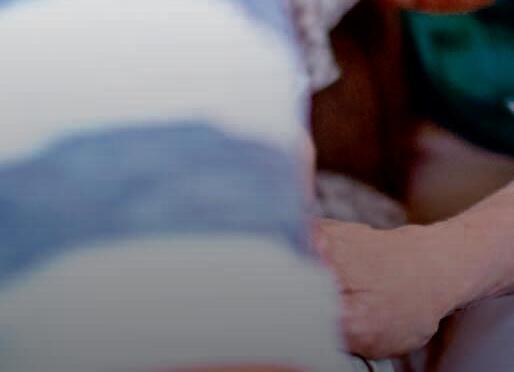

Wing Commander Jasbir Singh (Retd.) North Potomac, MD
•
•
•










 By Charon P.W. Hines
By Charon P.W. Hines
Happy Pride!
As we embrace the vibrant spirit of Pride Month, I am thrilled to share some exciting news about the upcoming events organized by the Department of Aging and Community Living (DACL) in collaboration with Mayor Muriel Bowser. We are gearing up for an active summer out in the community, and we invite you to join us in celebrating the diverse and resilient spirit of our older LGBTQ adults.
First, get ready for the highly anticipated Ms. Senior DC pageant on Saturday, June 3! The contestants have been working diligently on their presentations, and we are eagerly awaiting the crowning of our next Ms. Senior DC. Join us at the University of the District of Columbia (UDC) Theatre of the Arts at 2 p.m. for this remarkable event. To purchase tickets, please call the Model Cities Senior Wellness Center at 202-635-1900.
Next, on Saturday, June 10, we will proudly march alongside Mayor Muriel Bowser in the Capital Pride Parade. Demonstrating our support and solidarity, we will participate in the parade with our Senior Pride Trolley. If you identify as an LGBTQ adult age 60 and over, and wish to ride along with us during the parade, please reach out to my office at 202-7245626. While seats are limited, we welcome everyone to walk with the Mayor and DACL, showcasing our unity and commitment to inclusivity.


Continuing the celebrations, on Sunday, June 11, DACL will host a booth at the Capital Pride Festival. At the festival, our DACL outreach team will highlight our programs and services designed to keep you healthy, engaged and active throughout the hot summer months and beyond. I encourage you to connect with us during this festive weekend and celebrate the extraordinary contributions of our older LGBTQ adults, who show all of us, each and every day, how to live and love boldly.

In addition to Pride festivities, we have one of our most anticipated events approaching! On Wednesday, June 28, Mayor Bowser will host the 12th Annual Senior Symposium at Ballou Senior High School. Building on the energy from Older Americans Month, this year’s symposium is focused on highlighting housing resources the District has to offer seniors. The theme for this year’s symposium is “Educate, Empower, Encourage,” reflecting the Mayor’s commitment for seniors to stay in DC and to thrive in the very communities they know and love. We aim to educate you on available resources, empower you to take advantage of what’s afforded to you, and encourage you to continue to live boldly. The symposium will feature performances, educational sessions and exhibitors. To register, please contact my office at 202-724-5626.


As we move forward, we are excited to kick off our 2023 Centenarian Salute search! In September, we will honor some of our city’s oldest residents who are 100 years and older at our annual Centenarian Salute Luncheon. It will be the first luncheon since the public health emergency, and we can’t wait to celebrate our city’s most treasured and respected residents. If you know someone who has celebrated or will celebrate their 100th birthday by July 31, 2023, please call us at 202-724-5626.
As you can see, there’s an abundance of activities happening across the city throughout the month of June and there’s so much more coming this summer! Whether you’re interested in attending the Senior Symposium or joining us for Pride events, DACL is here to keep you connected and engaged.
I look forward to seeing you this summer as we come together to celebrate the strength and resilience of our community.
P.W. HinesOn May 25, Acting Director Charon P.W. Hines testified before the Committee on Executive Administration and Labor for her confirmation hearing. Thank you to all of our seniors who joined DACL in support of Acting Director Hines!
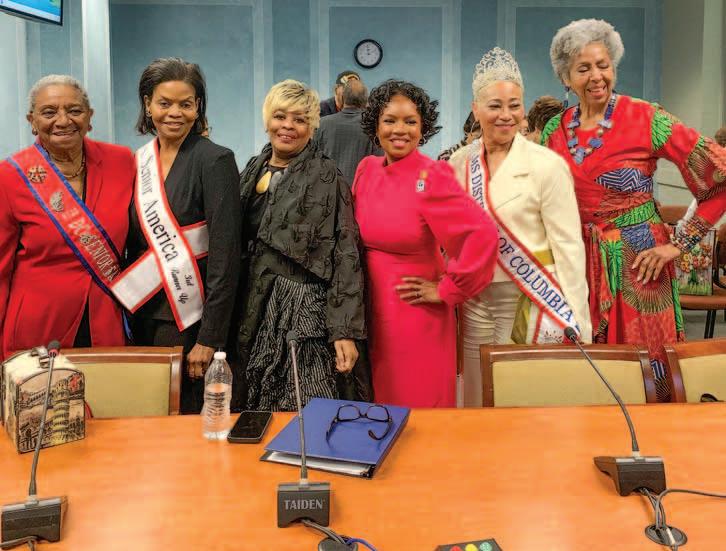

From captivating fashion shows to informative health fairs, this Older Americans Month showcased the true essence of aging unbound and living boldly in the District. The fashion shows exuded elegance and sophistication, illustrating that style knows no age boundaries. Additionally, the health fairs provided valuable resources and opportunities for sen-
iors to prioritize their well-being and access essential supports.
Thank you to all the seniors who actively participated and generously shared their stories. Your presence and engagement were what made Older Americans Month an outstanding success. We encourage each and every one of you to remain actively engaged and connected with us.



June is recognized as Elder Abuse Awareness Month, a time to shed light on the importance of protecting our older adults from neglect, abuse and financial exploitation. If you or someone you know is experiencing any form of mistreatment, please reach out to DACL’s Adult Pro-
tective Services hotline. Our dedicated team is available 24 hours a day, 7 days a week to provide assistance and support. Don’t hesitate to contact us at (202) 541-3950. Together, we can work towards ensuring the safety and well-being of our beloved seniors.
June is Pride Month and whether you choose to walk or roll you are welcome to join DACL on June 10 at the Capital Pride Parade . Let’s show that seniors paved the way, and celebrate our senior LGBTQ+ community. To register, please call us at (202) 724-5626.

Americans are finally reaping some benefits from keeping their money in the bank. Banks are paying up for savers’ deposits in a much bigger way than they have in more than a decade, based on recent earnings reports from the nation’s biggest banks.
After a decade of low interest rates, the Federal Reserve has unleashed a rapid series of rate hikes to combat inflation, pushing up its benchmark rate to a range of 4.75% to 5%.
That has prompted banks to pay higher interest on traditional savings products like money market funds, certificates of deposit and regular savings accounts.
A 24-month CD, a common savings product for medium-term savers, is now carrying an average yield of 4.81%, according to the Federal Reserve Bank of St. Louis. That’s up from a 1.18% yield only a year ago. Further, non-bank names like Apple are getting into the deposit game, giving savers even more options.
Banks were initially slow to raise their payouts as the Fed raised rates because they were awash in deposits.
But those deposits have shrunk over the past year because inflation forced consumers and businesses to dip into their savings. To bolster their deposits, banks are raising payouts to retain current customers and entice new ones.
Some investors, leery of the current volatility in the stock and bond markets, could find a zero-risk investment like a savings account or CD an attractive option.
The volatility was only heightened after the failure of Silicon Valley Bank in March. A mass exodus of deposits in a short period of time doomed that bank, leading depositors at other midsize institutions to pull some of their money as well, although the withdrawals appear to have abated for now.
In a sign of how competitive it is getting for bank deposits, electronics giant Apple Inc. unveiled a savings account that will pay a 4.15% yield for Apple Card users. The
savings account is in collaboration with Apple’s consumer banking partner Goldman Sachs — and actually pays out more than the 3.90% Goldman pays for deposits under its Marcus brand.
Interest-earning accounts are up Bank of America, the second largest bank in the country, told investors last month that it was paying on average 1.38% to customers for their deposits, up from 0.96% a year earlier. That figure is still low for BofA because the bulk of customers’ funds are in checking accounts, which typically pay the lowest yield.
Another banking giant whose customers mostly have checking accounts, Wells Fargo, says it’s paying 1.22% for interestbearing deposits versus paying just 0.04% for those same deposits a year earlier.
The big banks like BofA and Wells are still paying lower rates than most banks on their traditional savings accounts and checking accounts because they’re massmarket products. But the banks are offer-
A higher credit score can lower mortgage rates, insurance rates and more.

Learn how on page 31.
ing six-month and one-year CDs for 3.5% to 4%, according to the latest term sheets.
JPMorgan Chase executives told investors in April that, while it saw roughly $50 billion in deposits flow into the bank in March after the collapse of Silicon Valley Bank, it does not expect all of those deposits to stay with JPMorgan. Some are likely to move into higher yielding money market funds and CDs offered by other banks.
“It’s a competitive market, and it’s entirely possible that people temporarily come to us and then over time decide to go elsewhere,” said Jeremy Barnum, the bank’s chief financial officer, in a call with analysts.
Brokerage giant Charles Schwab said it saw significant movement of customer funds into money market accounts in the first quarter, as customers sought yield.
© 2023 The Associated Press. All rights reserved. This material may not be published, broadcast, rewritten or redistributed without permission.
Are you and your spouse planning to write your wills this season? Congrats! Will-writing is one of the most loving things you can do for each other and for all the people and causes that matter most to your life.
But if you’re thinking about implementing simple “I Love You Wills,” read on. While this simple will plan design can work well for many couples, for others, the practical impact is not very loving.
I Love You Wills generally refer to reciprocal last wills and testaments created by spouses. In their wills, each spouse leaves their entire estate to the other spouse outright, and then, in most cases, upon the death of the surviving spouse, the remaining assets are slated to pass to their mutual children.
These types of wills are often created by individuals making their wills for the first time who have simple estates and are anxious to have something in place before a significant life event (like getting married, having a first child or taking a long family vacation).
Others who create I Love You Wills may do so because they find the process of will creation emotionally draining or overly depressing (who wants to talk about death?), and seek out the simplest plan design rather than something more thoughtful that may take multiple rounds of drafting with an attorney.
I Love You Wills are popular because they are a simple and relatively inexpensive estate plan that, when circumstances go as planned, can effectively facilitate the plan of a couple with straightforward wishes and an uncomplicated estate — including the naming of a guardian for their minor children and pets and the distribution of their assets to their loved ones — thereby avoiding intestacy (that is, dying without a will).
Below are a few challenges that you may want to think about when considering if an I Love You Will is right for you.
Challenge #1: Control upon the survivor’s death
One of the most often cited concerns about an I Love You Will plan is that the
surviving spouse can change their will after the first spouse’s death (as long as they have the capacity). More particularly, they can easily eliminate or reduce gifts to children of the marriage in favor of a new spouse, new or stepchildren, or other beneficiaries who are not part of the original couple’s plan design.
Building a trust for the surviving spouse upon the first spouse’s death can help “lock in” the originally intended beneficiaries.
Appointing an independent trustee or co-trustee to serve alongside the surviving spouse and assess distribution decisions also makes it more difficult for assets acquired during the marriage to benefit new families or for the surviving spouse to disinherit mutual children.
Most spouses do intend to benefit their surviving spouse with the majority of their assets. However, philanthropically minded people often feel strongly about leaving something directly on their passing to a
cause that matters most (like, “Upon my death, I give $100 to [Favorite Charity]”), rather than waiting until both spouses have passed to start making a difference (like, “Upon my death, if my spouse has predeceased me, I give $100 to [Favorite Charity]”).
A plan design that simply states that all assets pass on the death of the first spouse to the survivor — including an I Love You Will plan — does not afford this opportunity to immediately create a lasting legacy and sustain an important cause for generations to come.
Imagine if, at the time of your passing, your surviving spouse was incapacitated and couldn’t manage their financial affairs — including any inheritance.
Most people would prefer to have their spouse’s inheritance managed by a trusted family member or friend nominated by them as opposed to being left to the discre-
Many who invested in bond mutual funds with long maturities in 2022 were disappointed because total returns were negative.
When interest rates increase, the value of long-term bonds falls. Thus, for investors who thought that bond holdings would protect them, a fall in fund prices was disappointing, because in 2022 both bond prices and stock prices fell dramatically in value.
What will happen in 2023 is hard to predict. If the rate of inflation falls and the Federal Reserve starts to cut interest rates, bond prices will increase and the value of bond funds with long maturities will increase, and equity prices will also rise.
Fortunately, for conservative investors, there are now much better alternatives for those looking for stable shorter-term conservative investments with reasonable returns.
For example, I had invested in Vanguard’s Federal Money Market Fund (VMFXX), which was returning over 4% at that time. The return on that fund is now over 4.5%. Vanguard requires a $3,000 minimum investment for that fund.





with no minimum and a similar yield.
A 4% yield on a municipal money-market bond fund is equivalent to more than 6% for someone in the 35% federal tax bracket.
If interest rates fall, you can liquidate the funds immediately and invest in a traditional money-market fund or other conservative investment such as Treasury bills or CDs.
funds will improve. But there is no certainty that will happen.
So, for conservative investors who are concerned about preservation of capital, it is prudent to consider investing some of your investments in shorter-term investments such as money-market funds, Treasury bills, Treasury notes and relatively short-term CDs.
By Elliot RaphaelsonMoney-market funds are very liquid, and you can sell shares quickly and convert them to cash whenever you wish. Fidelity also offers a comparable money-market fund.
Returns on CDs have increased dramatically since the beginning of 2022. Currently, you can find FDIC insured five-year CDs with interest rates of approximately 4.5%.
Hopefully, actions by the Federal Reserve will help curb inflation. If so, returns on traditional investments such as indexed equity funds and longer-term fixed income
As inflation comes under control, you can consider using dollar-cost averaging from conservative investments into conservative equity mutual funds/ETFs.
Fortunately, there are now short-term investment alternatives that offer reasonable returns as well as capital protection.
Elliot Raphaelson welcomes your questions and comments at raphelliot@gmail.com.





But no one can be sure if inflation will be controlled, and if inflation is not controlled better, then the Federal Reserve will not be taking steps to decrease interest rates.
At the beginning of 2022, investors looking for conservative investments that paid reasonable interest rates did not have very good options. The returns for Treasury bills, short-term CDs and money-market funds were very poor, in most cases less than 1%.
If you invest in ordinary money-market funds, there are no tax advantages. However, currently you can also invest in municipal money-market funds [which hold mostly tax-free investments] that now earn almost 4%. Rates may not stay that high, but while they do, and if you are in a high tax bracket, you should consider this investment.

For example, Vanguard offers such a fund, the Vanguard Municipal Money Market Fund (VMSXX), with a $3,000 minimum. Fidelity offers a similar fund, the Municipal Money Market Fund (FTEXX),


June 23
Would you like to have an attractive yet harvestable yard? In a free Zoom presentation, Kirsten Conrad, agriculture/natural resources extension agent for Arlington and Alexandria, will share design tips and best ways to grow fruit trees, perennial vegetables, herbs and annual edibles. The session takes place June 23 at 10 a.m. RSVP at mgnv.org/rsvp-for-public-education-classes for a link to participate, or call (703) 228-6414.
From page 26
tion of a court (remember, the court can select someone you would not have picked). An arrangement that leaves assets outright to the surviving spouse is less protective in such an event.
On the other hand, establishing a trust for the surviving spouse under the management of a trusted nominee you select can help ensure that assets are managed sensibly for their benefit if they are or become unable to independently manage their finances.
Two-thirds of American adults report not having a last will and testament. Estate planning professionals agree that, in most cases, having a simple will — including an I Love You Will — is much better than having no will at all.
In addition to providing for the distribution of assets on death, spouses use their I Love
June 24
You Wills to name guardians for minor children and pets. They also name will executors (and sometimes digital executors to handle a will-maker’s digital accounts and assets) to settle their estates and account for the payment of estate expenses, including taxes. Also, simple I Love You Wills can perform admirably when everything goes as expected. However, in certain cases, implementing an I Love You Will can have unintended consequences or represent missed opportunities to start supporting a favorite cause at the first spouse’s death or protect a loved one — including in the event of incapacity.
So, if you and your spouse are getting ready to write your wills this season — whether it’s an I Love You Will or a plan design with a bit more complexity — be sure to be thoughtful and intentional, and select the plan that is going to love you back.
© 2023 The Kiplinger Washington Editors, Inc. Distributed by Tribune Content Agency, LLC
The Village of Takoma Park in Maryland will host a solstice celebration on Sat., June 24 from 2 to 5 p.m. All are welcome for the free food, drinks and live music. Every confirmed RSVP receives a free raffle ticket. Meet outside the VFW Post 350 at 6420 Orchard Ave., Takoma Park, MD. To register for this free event, go to bit.ly/Takomasummersolstice or call (301) 646-2109.









Mo ded eld com may
y ph or fi of e family members, who seek to take vulnerable perso

Y Yoou can take the step towards prev
by learning about the warning signs and available resourc
National Center Abuse cites some these as signs:
unexplained bruises
isolation
depression
f feear/anxiety
ntgomer y County is dicated to preventing er abuse in our mmunity. Elder abuse y f y take man foorms — ysical, emotional, sexual financial. Perpetrators elder abuse may include caregivers or outsiders advantage of a n. first vention t the d es. The on Elder e of bruises
it anonymously to the Adult Protec tive Ser vices I ntake line at (240) 777-3000.

The Montgomer y County Adult Protec tive Ser vices (APS) Program — which investigates elder abuse, neglec t and financial exploitation — relies y primarily on members of the community, , ned family and neighbors f concer foorits ef case r feerrals.
APS provides ser vices to vulnerable adults 18
years of age and older who lack the physical or mental capacity to vide f pro foor their daily needs. Social workers a nurses will investigate cases of self-neglect, neglect, physical abuse andfinancialexploitati
kers and
and financial e tion, while offffeering county resources to ensure s health, saf ’ and protect the client’s feety and welfare.
lack of medical care
unusual behavior or changes in sleep
unpaid bills or changes in spending patterns. (See more at https://bit.ly/ SomeSignsOfAbuse.)
Isolation is one of the most common warning signs that a vulnerable adult is at higher risk. A perpetrator (par ticularly when a family member or caregiver) may ’ take away the senior ’sscell phone or prevent loved ones and friends from visiting Scammers may attempt to take ’ advantage of someone’s s loneliness by offffeering companionship online or via the telephone, but their true goal is to steal seniors’ money
If you are concerned about the welfare of a vulnerable adult, please repor t
Additionallyy, , APS is par t of the Montgomer y County Elder & T Vulnerable Adult Abuse Taask Force, a multi- disciplinar y team comprised of government agencies that educate, emedy prevent, r y, , investigate and, when needed, prosecute elder abuse to ensure the saffeety of vulnerable adults.











thermembersofthetaskf O foorce include ’ the Montgomer y County State’s s Attorney ’s O ffice, Police, Ombudsman, O ffice of the ney County Attor y, , and the Montgomer y County Fire and Rescue Ser vice. I t also par tners closely with the O ffice of Consumer Protec tion.
Y If Yoou See Something, Say Something! Call Montgomer y County Adult Protec tive Ser vices at (240) 777-3000 or email: ADS@ Montgomer yCountyMD.gov.
We’ve all read stories about Britney Spears, Amanda Bynes, Brian Wilson of the Beach Boys and other famous people who lost control over their own lives. These individuals were legally stripped of their autonomy, and another person was vested with the power to manage their finances, medical choices and other life decisions.
Guardianships — also referred to as conservatorships — are drastic and invasive. They essentially deny people control over their own lives and establish someone else as the decision-maker.
For this reason, they require a rigorous showing of legal incapacity, as well as approval by a judge. In many jurisdictions, parties must establish a specific need for
guardianship, and demonstrate that other alternatives considered would not adequately protect the individual.
Guardianships should never be undertaken lightly. Once established, they can be extremely difficult to undo (witness the Britney Spears case), so other options should always be considered first.
Guardianships do serve an important purpose: They ensure that individuals unable to handle their own affairs are not exploited or otherwise injured. They also provide a safety net for estates whose heirs might otherwise recover nothing when a loved one dies.
However, other legal vehicles can pro-
vide similar oversight with far less complexity.
That being said, there are circumstances when a guardianship may be the best — or only — choice. Imagine, for example, a man with dementia who lacked the foresight to make adequate provisions in his will or trust for management of his affairs. Without a plan for oversight of his assets, he could end up jeopardizing the estate he intended to pass on to his heirs.
Those heirs are often best situated to seek a court-appointed guardian who will ensure that their father or grandfather does not sign away his estate or compromise his physical well-being.
On the other end of the spectrum, imagine an older relative who left funds for a future generation without making provisions for oversight of those funds. If she passes away leaving minor beneficiaries, their parents must seek a guardianship so they can manage the money until the children reach the age of majority.
Although laws vary from state to state, every state requires that less restrictive alternatives be considered before invoking a guardianship. These might include such vehicles as limited guardianships, powers of attorney or assisted decision-making agreements.
The benefit of these alternatives is that they don’t require court approval or judicial oversight. They are also much easier to set up and shut down. The standard for establishing incapacity is also less rigorous than the standard required for a guardianship.
Limited guardianships take away the subject’s right to make decisions, just as full guardianships do, but they are focused on specific aspects of the person’s life.
A limited guardianship can be established for the purpose of managing the subject’s finances and estate, or it can be set up to control medical and healthcare decisions.
Such guardianships still require court approval and must be supported by a showing of incapacity. As with full guardianships, these more limited interventions will be continued for as long as the incapacity lasts, and can only be dissolved through judicial processes.
If practicable, limited guardianships are the preferred vehicle for protecting people and their property. Courts don’t want to restrain a person’s rights any more than is necessary.
Powers of attorney can be established for medical or for financial decisions. Far less difficult to set up than a guardianship, a financial power of attorney can be as simple as putting a second person on the bank account of an incapacitated or otherwise vulnerable individual. This second set of eyes ensures that financial decisions are well-considered and not harmful to the estate.
A medical power of attorney can enable

the second person to obtain an injunction to protect the health and well-being of the subject, including by seeking a determination of mental incapacity.
A durable power of attorney for healthcare matters invests the second person with the right to make medical decisions on behalf of the subject if or when they are unable to do so for themselves. Unlike a guardianship, powers of attorney can be canceled when they are no longer needed.
An assisted decision-making agreement establishes a surrogate decision-maker who has visibility to financial transactions. The bank is notified of the arrangement and alerts the surrogate when it identifies an unusual or suspicious transaction.
Although such an arrangement does not completely replace the primary account holder’s authority, it establishes a safety mechanism to prevent exploitation or fraud. The bank is on notice that a second approval is required before an uncommon transaction can be completed.
Many of the issues for which guardianships are created can be addressed in a will or revocable trust. These important estate-planning documents allow individuals to map out what will happen in the event they become incapacitated or otherwise incapable of managing their affairs.
Trusts can avoid guardianship by appointing a friend or relative to manage money and other assets. A contingent trust will allow the executor to manage assets if necessary.
For older individuals, it may be prudent to establish a co-trustee who can oversee matters and step in should the trustor lose the capacity to make good decisions.

Choose a potential guardian now Transparency is important. Before it becomes necessary for a guardian to be appointed to handle your physical or financial decisions, think about whom you would trust to act in that capacity — and put it in writing.
Let others know that if a guardian is needed, this is the person you want to serve in that capacity. A one-page directive will make your wishes clear and avoid giving this important decision to a judge.
Delegate a second set of eyes now to support you down the road — preferably someone younger, with a fresh perspective and a good understanding of money management.
If you don’t think about these things now, the state will make the decision for you. Talk with your legal and financial advisers and create the documents now that will save your loved ones from having to seek a guardianship for you in the future.
© 2022 The Kiplinger Washington Editors, Inc. Distributed by Tribune Content Agency, LLC.
Becoming a homeowner has become increasingly more challenging for many, with monthly housing payments recently hitting a record high of $2,563 — a 29% increase from 2022. Sky-high mortgage rates, which are expected to keep climbing, have left both homebuyers and owners feeling increasingly pessimistic about the housing market outlook.
So, if you’re in the market for a mortgage or a refinance, it’s more important now than ever to ensure you can secure the lowest mortgage rate possible. One way it can be done is by prioritizing a good credit score.

[Ed. Note: A high credit rating can also reduce your homeowners’ insurance, car insurance and mobile phone contracts. In addition, according to NerdWallet, “senior housing, assisted living and continuing care retirement communities also may use credit histories or scores to evaluate applicants.”]

Lenders take into account a variety of factors when determining the interest rate on your mortgage, including down payment, loan term and the price of the property.
However, the biggest factor determining your mortgage rate is your credit score. Most lenders will take into account your FICO score, which can range from 300 to 850.
• 800 or higher: Exceptional
• 740-799: Very good


• 670-739: Good

• 580-669: Fair
• 579 or lower: Poor
To qualify for a mortgage loan, you’ll likely need a score of at least 620. Howev-
er, having a higher score can ease the financial burden of a mortgage, as it can help get you lower rates. And the knock-on benefits continue — securing a low mortgage rate can help lower your monthly payments substantially, according to this data from MyFICO:
Say you start with a credit score of 620639. Here’s how much you’d save over the course of your 30-year fixed mortgage of $350,000 by boosting your credit score:
—If your score changes to 640-659, you could save an extra $47,086.
—If your score changes to 660-679, you could save an extra $83,473.
—If your score changes to 680-699, you could save an extra $101,343.
—If your score changes to 700-759, you could save an extra $116,000.
—If your score changes to 760-850, you could save an extra $134,220.
Your credit score matters to lenders because it shows them how likely you’ll be able to repay your loan. If you have a higher credit score, lenders won’t see you as a risky borrower.
And while you can still get approved for a mortgage with a bad credit score, you won’t be able to secure the lowest rates possible. If you want to save on your mortgage rates, try these steps to boost your overall credit score before applying.
Check your credit report: Before applying for a mortgage, get a copy of your credit report. [Ed. Note: You can request one free copy of your credit report each year from each of the three major consumer reporting companies — Equifax, Experian and TransUnion — by visiting AnnualCreditReport.com.]
You’ll be able to see a complete rundown of your credit history, helping you identify areas of your credit that are hurting your score, while also checking for any inaccuracies in the report.
Having errors on your credit report is more common than you may think, so it’s important to get those fixed by filing a dispute.
Make on-time payments : Payment history is the largest factor affecting your credit score, accounting for 35% of your total score. Because of this, it’s vital to always make payments on time, as missing

payments can significantly decrease your score.



Pay off credit card balances: Credit utilization is the ratio between any debt you have compared to your total credit limit, and it makes up 30% of your overall credit score. Therefore, keeping your credit utilization as low as possible can help you up your overall credit score. A good rule of thumb is to keep your credit utilization below 30%.
© 2023 The Kiplinger Washington Editors, Inc. Distributed by Tribune Content Agency, LLC.















































 By Glenda C. Booth
By Glenda C. Booth
On a summer stay in Boothbay Harbor, Maine, I decided to go to a concert at the local opera house. When I picked up my tickets at the box office, the agent opened a plastic box, grabbed a batch of tickets bound with a rubber band and handed me my paper tickets.
No Internet, no password, no clicking, no online headaches. The whole experience took two minutes.
Such is Maine. Longing for root beer? Old Harleys? A 1950s drive-in? Many spots in Maine take you back to yesteryear.
Fresh lobster, saltwater taffy
Head for the Atlantic coast and you’ll likely happen upon the essence of Maine: a lobster pound, operating (and smelling) as it did 70 years ago.
Here, fresh-from-the-sea lobsters are cooked in seawater on the spot, as seagulls stand ready to steal a morsel from tourists, and boats sputter in and out of the harbor, bringing in the day’s haul. Most pounds are modest wooden buildings with walk-up ordering windows, outdoor tables, and plenty of paper towels for messy dining. The classic dinner is a whole lobster with melted butter, an ear of corn and, of course, a bib. Patrons also can feast on lobster rolls, chowder and steamed Maine clams and mussels.
Many small towns in Maine have an oldfashioned candy shop, too. “Candy knows no social barriers,” reads a sign at Orne’s in Boothbay Harbor, established in 1885 by Addie Orne.

The one-room shop’s tantalizing glass cases and tables are full of lobster pops, saltwater taffy, chocolate blueberries, redlace licorice and Needhams, a Maine tradition — candies with coconut and mashedpotato centers covered with chocolate.
Traditional diners from pre-interstate days dot the state, like Moody’s in Waldoboro. “When I get hungry, I get Moody,” read the T-shirts for this beloved eatery, which Bertha and Percy Moody opened in 1927. The couple had nine children, some of whom still work there.
Loyal locals and tourists chomp down fat haddock Reubens, hearty chowdahs (Maine-speak), and homemade fluffy biscuits to die for.
At the counter, you’ll likely chat with a truck driver or lobsterman and indulge in Moody’s famous homemade pies — blueberry, lemon meringue, banana cream and peanut butter. On an average summer day, Moody’s makes 50 to 60 pies and serves as many as 1,500 people.
Maine’s 1950s drive-in restaurants remain in full swing today. At Fat Boy’s in Brunswick,
open since 1955, a sign instructs, “Lights on for service.” Turn on your headlights and a server sprints out to your car, takes your order, hooks a tray onto the car window, then returns with your burger and fries.
Fast Eddie’s drive-in, located in a former Texaco gas station in Winthrop, also has carhop service. Inside, there’s 1950s memorabilia, gold and burgundy vinyl booths, a checkerboard floor and a working jukebox.
At the Fountain in Bath, customers can choose a soda fountain stool or a blackand-white semicircular booth under a pressed-tin ceiling and enjoy Maine blueberry treats, milkshakes, sundaes, cream soda and root beer.
Maine does offer much more than food. For indoor amusement, try candlepin bowling, a game likely “imported” from the Canadian Maritime provinces.
Players fling balls smaller than traditional ones, without finger holes. The skinny pins they aim to knock down resemble candles. Candlepin alleys only have several lanes, so they’re not as noisy as typical urban bowling alleys.
Trips to see Atlantic puffins never disappoint. Boat tours from Boothbay Harbor, Rockland and Port Clyde reveal a closer look
at the islands where puffins return every year to raise their chicks, known as pufflings. There’s also shopping. Every shopper’s bucket list should include a roam through a Reny’s Department Store. Mainers would never call it a “chain,” but Reny’s has 17 locations around the state.
Walmart it’s not. Shelves are crammed with everything from crayons to spatulas, moose-themed pajamas, lobster socks, blueberry preserves, Katahdin coffee, flannel shirts, balsam candles and insect repellent. Their motto of 73 years: “If Reny’s Doesn’t Have It, I Don’t Need It!”
Nostalgic for your old stick shift, metal bumpers and backseat, pre-seat-belt adventures? Maine has four car museums that spotlight antique vehicles.
The Owl’s Head Transportation Museum displays more than 150 of them, including automobiles from 1886 to 1963. You can reminisce about teenage hot dates as you ogle the lipstick-red 1957 Ford Thunderbird and some old Harley motorcycles.
Or try the Seal Cove Auto Museum near Bar Harbor, with cars made between 1895 and 1917. The Stanley Museum in Kingfield preserves “the Stanley Family genius” — 1905, 1910 and 1916 steam cars,
When my wife Fyllis and I first saw the ship that would be our home for a week, we were impressed. Our room — a spacious outside stateroom with private balcony — rivaled those in many upscale hotels.
The food and table settings in the ship’s dining room were both five-star, with a welcome all-inclusive policy (so that second dessert and adult beverage are “free”).
But we weren’t on one of those megaships designed to hold thousands, like cities on the water. Our vessel accommodated only 180 passengers, offering the intimacy of a smaller setting and far fewer people, yet with facilities, amenities and on-board and on-shore activities comparable to huge ocean liners.
Fyllis and I were enjoying one of more than 50 small ship itineraries available from American Cruise Lines, which plies rivers and other waters through 35 states in vessels that hold between 90 and 180 passengers.

Our Lower Mississippi River cruise offered opportunities to explore inviting Southern towns that provided deep dives into Civil War and other history, visits to magnificent antebellum mansions, and strolls through lovely gardens.


In addition, we were able to explore museums that brought to life prehistoric times, Native American history and
African American history in a fascinating corner of the country.
Between Memphis, Tennessee (our embarkation point) and our first stop, Vicksburg, Mississippi, we saw a lot of nothingness.

Both shorelines are blanketed with woodlands. The only river traffic was an occasional “pusher” towboat pushing a long line of multiple barges.
In addition to on-board educational and entertaining programs, we enjoyed relaxing on our balcony, reading books and watching the mighty Mississippi River.
Fyllis and I were thus excited to set our feet on land and explore the first of the historic towns along our route: Vicksburg, Mississippi. We walked to some attractions that are close to the ship dock, and rode in provided tour buses to reach others.
A series of large murals along the waterfront depicts various scenes from the town’s past. These include the role of the river in the rise of the community and the contributions made by African Americans.
The city’s brick streets led us to a Civil War Museum, Vicksburg National Military Park, and an early 19 th-century church with beautiful Tiffany windows.
I was enthralled by a home that served as

a hospital during the Civil War, with Union and Confederate soldiers recuperating on different floors. We paused in front of another house whose iron gate was still bent where a cannonball struck it during the war.
The next stop in Mississippi was Natchez, which was established by French colonists in 1716 and became part of the United States in 1783. Planters forced enslaved people to grow cotton and sugarcane, and built expansive mansions to demonstrate their wealth.
Many of these stately homes survive to relate part of this story, while the Natchez Museum of African American History and Culture tells the rest. One tour of this town
includes a stop at a historically Black church to hear a Gospel musical performance.

We docked at tiny St. Francisville, Louisiana (pop. 1,600) on day five. Theb Rosedown Plantation there, which once enslaved 450 people, is surroundedby formal gardens dating from the 19th-century.
More gardens are in bloom at the Audubon State Historic Site at the Oakley Plantation. Along with a blacksmith shop and cabins that housed enslaved people, it includes the home where John James
From page 33

like the Stanley Steamer invented by Mainer Francis Stanley.


If you’ve ever used the word “icebox” to describe a refrigerator, you may enjoy visiting a historic ice house in South Bristol. In 1826, Asa Thompson dammed a stream, created a pond, and started cutting ice, selling it to anglers, delivering it to customers or shipping it as far away as Philadelphia, Cuba, China and India.
Today, Thompson’s is likely the only commercial ice house on the National Register of Historic Places to continue to store
From page 34
Audubon lived in 1821, while working on 32 of his famous bird paintings. As in Audubon’s time, the site still is a bird-lover’s paradise.
Baton Rouge, where we spent our sixth day, has an interesting origin story for its name. In 1698, French explorers sailing up the Mississippi River spotted a red pole along the shoreline. After learning that it marked the boundary between the hunting grounds of two Native American tribes, they called the site le bâton rouge (the red stick), and the name stuck.
Over time, seven different governments oversaw the town, which grew to become the second largest city in Louisiana. In 1846, it was designated the state capital to replace “sinful” New Orleans.




Today, Baton Rouge is a culturally diverse community with 222,000 residents of many ethnic and religious backgrounds. Adding to the mix are college students from Louisiana State University and 10 other schools in the city.





naturally frozen ice harvested from a nearby pond using the traditional method.
Videos and docents explain how workers cut big ice blocks with hand saws and tug them up an incline into the ice house for storage. Locals have an ice harvest here every February.
Of course, Maine is also famous for its lighthouses, many of them decommissioned but still picturesque. To visit one of the state’s 65 lighthouses, take a one-mile boat ride from Boothbay Harbor to the Burnt Island Light Station.
There, time travel does seem possible. Interpreters in 1950s clothing (remember gingham dresses and Keds?) portray the lighthouse keeper and his family during the time Harry Truman was president.
The city’s sites include the Capitol Park Museum, which traces contributions of Native Americans, early European colonists, enslaved people and others to the area’s development and accomplishments.

Exhibits at the LSU Rural Life Museum, a complex of 32 historic buildings, focus on the way of life of 18th- and 19th-century Louisianans.
Our voyage ended in New Orleans, which included a guided excursion to the famous French Quarter and lovely Garden District.
While some of New Orleans’ homes rival the beautiful plantation houses we encountered during the cruise, many are relatively modest in comparison.
My personal favorite, Houmas (pronounced Hummus) House, located between Baton Rouge and New Orleans, has appeared in various films and TV series. An oak tree alley leads the eye to the front of the graceful house, and resident geese and ducks act as noisy sentries.
Electricity didn’t arrive at the 1821 lighthouse until 1961. Water for home use was precious, most collected in a 2,000-gallon cistern. Saturday was “bath day,” one of the “daughters” told a group of visitors on a summer tour. “The cleanest girl goes in first.”
It’s a 10-hour drive from D.C. to Portland, depending on the route and traffic. However, you can fly round-trip to Portland on Southwest for around $400. If you fly, a rental car is a must.

One way to “do Maine” is to go to a “grown-up camp,” such as the Hog Island Audubon Camp. Campers stay in dorm-like lodges, have communal meals, take photos, paint landscapes and learn all about

The plantation was established in the late 1700s on land inhabited by Native Americans known as the Houma. The main Greek Revival mansion, built around 1829, was the focal point of a major sugarcane operation, successful due to the labor of up to 800 enslaved men, women and children.
The tour of the restored antebellum mansion allows a glimpse of its rare period furnishings, art and artifacts.

Then there are the gardens. The 38 acres of colorful native and exotic plantings serve as the backdrop to a museumquality collection of sculptures.
terrestrial and sea birds in classes and on field trips. See hogisland.audubon.org.

Boothbay Harbor is a good home base for day trips to Bath, Camden and other sites. You can stay in cottages, B&Bs or hotels, but the Mid-Town Motel in Boothbay Harbor bills itself as “a true 1950s classic” — an 11-room motor lodge run by the same family for 66 years (until last year, but it retains the olden days aura). When the movie Carousel was filmed in town, the cast stayed in the Mid-Town (midtownmaine.com).
Its turquoise and white outdoor color scheme, indoor knotty pine walls, and cheery window flower boxes are far removed from today’s monotonously similar chain hotels. But yes, it has WiFi.
To plan your trip, go to visitmaine.com.




The challenge facing travelers selecting an American Cruise Lines trip is choosing from the long list of destinations, ships and experiences. Its boats ply the Mississippi, Columbia, Ohio, Hudson and other rivers, go through the Chesapeake Bay, along Maine’s coast, and on a long list of other waterways.
Fares for the week-long Lower Mississippi River Cruise that we enjoyed begin at $4,125 per person; some include domestic airfare. The cost of other itineraries is as low as $2,405. See americancruiselines.com.
For more information, call 1 (800) 814-6880 or visit americancruiselines.com.

I get tired of articles I read about how to “save money” on travel. “Saving” money means putting it into an IRA or a CD or a kids’ college fund. This year, you’re going to spend money on travel — lots of money, given the near-universal inflation. What you want to do is spend it most efficiently — to get the most bang for the buck.
And that doesn’t mean squeezing a few dollars out of your airfare cost, along with a few days out of your vacation, by flying midweek. It means making some basic trade-offs on how and where you spend.
your money is to take advantage of deals.
Some deals are perennials, broadly available over years and decades.
Those Groupon hotel, resort and tour coupons are almost always good deals. Eurail Pass has been a good deal forever.
AARP discounts aren’t big, but they’re almost always available, and to anybody, not just seniors.
One tried-and-true way to get the most for
Road Scholar learning vacations have been good deals for folks age 50 or over for decades (since they started out as Elderhostel).
You also find some good deals that come and go. Right now, for example, cruising can be a very good deal. I generally look at Cruise Critic to check on deals,
and I see quite a few offers starting at less than $75 per person per night — a few even less than $50 per person — and a bunch with large on-board credits and upgrades. My big beef with cruises is being off line for a week, but I’m weird that way.
Another way to avoid high costs is to go downmarket. Sure, a luxury hotel is nice, but you can get a good night’s sleep and enjoy a dip in a pool at even a modest budget property. These days, even in Europe, many budget properties offer airconditioning and private baths.
Going downmarket isn’t a universal solution, though. The downmarket experience can never completely replace what you get by paying more.
I see so many suggestions about avoiding the highest-cost cities such as New
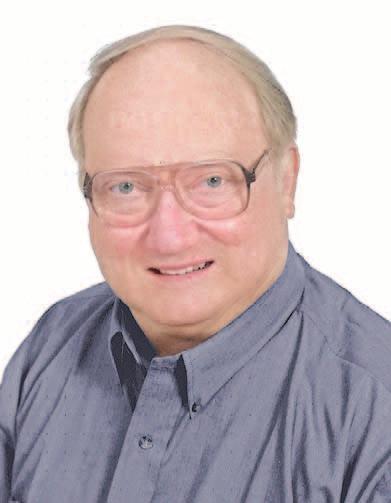
The Greens at Hammonds Lane: 410-636-1141
Park View at Furnace Branch: 410-761-4150
Park View at Severna Park: 410-544-3411
BALTIMORE CITY
Ednor Apartments I: 410-243-0180
Ednor Apartments II: 410-243-4301
The Greens at Irvington Mews: 410-644-4487
Park Heights Place: 410-578-3445
Park View at Ashland Terrace: 410-276-6440
Park View at Coldspring: 410-542-4400
BALTIMORE COUNTY
Cove Point Apartments I: 410-288-2344
Cove Point Apartments II: 410-288-1660
Evergreen Senior Apartments: 410-780-4888
The Greens at English Consul: 410-789-3000
The Greens at Liberty Road: 410-655-1100
The Greens at Logan Field: 410-288-2000
The Greens at Rolling Road: 410-744-9988
Park View at Catonsville: 410-719-9464
Park View at Dundalk: 410-288-5483 • 55 & Better
Park View at Fullerton: 410-663-0665
Park View at Miramar Landing: 410-391-8375
Park View at Randallstown: 410-655-5673
Call
BALTIMORE COUNTY (CONT.)
Park View at Rosedale: 410-866-1886
Park View at Taylor: 410-663-0363
Park View at Towson: 410-828-7185
Park View at Woodlawn: 410-281-1120
EASTERN SHORE
Park View at Easton: 410-770-3070
HARFORD COUNTY
Park View at Bel Air: 410-893-0064
Park View at Box Hill: 410-515-6115
HOWARD COUNTY
Park View at Colonial Landing: 410-796-4399
Park View at Columbia: 410-381-1118
Park View at Ellicott City: 410-203-9501
Park View at Ellicott City II: 410-203-2096
Park View at Emerson: 301-483-3322
Park View at Snowden River: 410-290-0384
PRINCE GEORGE’S COUNTY
Park View at Bladensburg: 301-699-9785 • 55 & Better
Park View at Laurel: 301-490-1526
Park View at Laurel II: 301-490-9730
York, Boston and San Francisco. Yes, living costs in Kalamazoo, South Bend or Topeka are a lot less, but you can’t see a Broadway show, walk the Freedom Trail, or ride a cable car there.
Sometimes, though, you can come close to closing the gap. Currently, if you aren’t staying at one of the affiliated hotels, you pay $675 plus a $50 cart fee to play a round at iconic golf mecca Pebble Beach. But you can enjoy a spectacular oceanside round at Bandon Dunes for about half that and at Half Moon Bay for $65 to $180.
Another idea for minimizing your cash outlay this summer is to use up your frequent-flyer miles. Airlines are steadily devaluing their mileage by raising the mileage “price” for award travel: The longer you hold your miles, the less they’re worth.
If high airfares give you sticker shock, consider a road trip. Gasoline prices are down from their earlier high, but if your primary vehicle is a gas-guzzler, you can rent a more economical model.
And small-town and highway hotel rates are almost always less than rates for comparable accommodations in big cities.
A road trip through the countryside has always been one of my favorite ways to tour Europe, and the car rental company Auto Europe is currently running a sale featuring discounts up to 20 percent.
The best available rates are pretty similar in France, Germany and Italy (base rates $31-$46/day), and even less in Portugal and Spain ($16-$20). Just make sure to rent with a credit card that covers you for collision damage in the country where you rent.
For minimum rates, avoid surcharges for rentals starting at major airports or rail stations.
Cutting costs is always a good idea, but don’t cut so far as to compromise with what you really want to do. Prices are up for just about everything these days, so expect to pay for travel. Just don’t overpay for what you really want to do.
Email Ed Perkins at eperkins@mind.net or visit his rail travel website at rail-guru.com.
BEACON BITS
June 18
DEMONSTRATION
GARDEN OPEN HOUSE
Stop by two of Arlington’s demonstration gardens to ask a master gardener all your questions about plants. Learn about the best plants for your sunny or shady yard — for free. Visit the Sunny Garden or the Quarry Shade Garden on Sun., June 18, from 1 to 3 p.m. at Bon Air Park, 850 N. Lexington St., Arlington, VA. For more information, call (703) 2286414 or email events@mgnv.org.
In order to have more confidence while away from home, it’s essential to be prepared to handle the little things. This will help you avoid unnecessary (and difficult) stops at pharmacies in unfamiliar terrain.
Today, I’m sharing the 12 most important things to pack for your next trip, based on my own experiences. I bet there’s something in my list that you haven’t thought of before. For me, I like to take unit-dose pills or capsules rather than pack the entire bottle of these items, because not doing so will fill up your suitcase pretty quickly.
On the other hand, for chronic medical conditions requiring prescription medication, pack in their original packaging or prescription bottle.
Let’s dive into the 12 indispensable items, from a pharmacist’s perspective, to keep your travels smooth and enjoyable.
1. Antihistamine — For mild allergic reactions or itchy rashes. Claritin for day use, and Benadryl at night.

2. Cold medicine — A nose spray can help with nasal congestion or a sinus headache.
3. Anti-itch cream — Hydrocortisone cream relieves itching from bug bites, rashes and other minor skin irritations.
4. Sleep aid — Not sleeping properly on your trip will cause misery. I recommend
melatonin for jet lag, but if you have Benadryl as your antihistamine, that will also put you to sleep. You can also check out my custom formula called Sleep Script.

5. Eye drops — A redness-reliever eye drop can soothe irritated eyes from air travel or allergies.
6. Earplugs — Silicone earplugs can help you sleep through loud noises at night.
7. Pain reliever — Ibuprofen or acetaminophen are the two that I recommend. Either one of these can help relieve pain from headaches, toothaches and muscle aches that may occur during travel. Acetaminophen is a little better for fever if you happen to get sick.
8. Anti-diarrhea medication — Imodium or other anti-diarrhea medication, along with a probiotic, can alleviate traveler’s diarrhea.
9. Electrolyte solution — Pedialyte or similar solutions replenish fluids and electrolytes lost due to diarrhea or vomiting. It will also help you with leg cramps! You can take powder stick packets with you and make your own with some bottled water.
10. Antacids — Tums or Pepcid AC can alleviate heartburn or acid reflux symptoms after eating some spicy Pozole Rojo!
11. Bandages and antibiotic ointment — Treat minor cuts and scrapes with items like Neosporin and bandages.
12. Ginger capsules or tablets — Useful for nausea, motion sickness or queasiness from winding roads or windy boat rides.
If traveling with insulin and needles, inform the airline, pack in carry-on luggage, and comply with TSA guidelines, including proper labeling and temperature control measures.
Packing these essential OTC medications and supplements can prevent or alleviate many travel-related health issues, so you can focus on enjoying your trip.
Before closing, consider the destination. Some countries, such as India, Cambodia,
June 24
Laos, Myanmar, Egypt, Mexico and Thailand, have a slightly higher risk of diseases due to inadequate sanitation or water treatment facilities in some regions. You are more likely to experience traveler’s diarrhea or other diseases like cholera or typhoid fever there.
This information is opinion only. It is not intended to treat, cure or diagnose your condition. Consult with your doctor before using any new drug or supplement.
Suzy Cohen is a registered pharmacist and author of The 24-Hour Pharmacist and Real Solutions from Head to Toe


Take a free walking tour of Congressional Cemetery to learn about leaders of the women’s suffrage movement. The history tour takes place on Sat., June 24, at 10 a.m. For more information or to register, visit bit.ly/suffragetour.
Want to help immigrants and refugees from Afghanistan and Ukraine learn English? The Washington English Center is seeking volunteers to teach either online or in person. No prior experienced needed; training and support will be provided. You can also be a writing tutor or online conversation tutor. For more information, visit washingtonenglish.org/volunteers or call (202) 387-2222.
Ongoing
AARP believes in celebrating the diversity of the LGBTQ+ community across all generations. That’s why we offer tools, programs and services to help you get the most out of your fabulous life. We all want to live longer, healthier and more fulfilling lives. AARP is committed to creating a new vision of aging for LGBTQ+ individuals, their families and allies—one focused on equity and inclusion and complete with diverse experiences, powerful stories, and innovative ways for everyone to pursue their passions—joyfully, openly and proudly! Keep an eye out for AARP DC at this year’s Pride Parade on June 10th. AARP DC and our volunteers will be walking the route!
Get to know us at aarp.org/pride

For summer reads by three local authors, see page 42.

























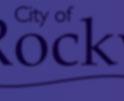
It turns out that pairing a Midwestern historian who writes a bestselling book on the Chinese Exclusion Act with a Hollywood producer who wants to turn it into television gold is a recipe for a hilarious and moving comedy.

At least, this is true for Exclusion, the 10th production in a series of works Arena Stage theater commissioned for its Power Plays initiative. It is also longtime Artistic Director Molly Smith’s final play with the theater. Director Trip Cullman’s guidance and Kenneth Lin’s taut, witty writing come together to make this play spark. Every line falls with perfect impact — or smacks the next line like a well-aimed pool shot.
I could not look away from the scenes between producer Harry (Josh Stamberg) and historian Katie Yang (Karoline), as they spar to shape the TV mini-series for their own ends. In each interaction, they infuse politeness and empty praise with dissonance, manipulation or emotional turbulence.
Harry, a self-confident White man with a recipe for success, has the edge early on. He flattens Katie with charm and jabberwocky. Stamberg’s torrential speech can
abruptly give way to a fraught question with the unexpected suddenness of glacial ice calving into the sea.



Ambitious and brilliant Katie feels strongly about educating a wider audience about the discriminatory Chinese Exclusion Act, which barred Chinese immigration between 1882 and 1943, and imposed harsh restrictions on Chinese people already in the U.S.
But she’s unsure of her footing in Hollywood, and she agrees with her documentary filmmaker husband, Malcolm (Tony Nam), that Los Angeles’ warmth and luxury would be a welcome change from the Midwest. Luxury and success may require serious compromise.

The play’s funny dialogue contrasts with the red lighting that slashes the stage by lighting designer Adam Honoré and suspenseful dramatic music from Hsin-Lei Chen. Both underscore the tension between expert and newcomer, accuracy and entertainment, historical truth and emotional truth — a hit or a failure.


The project is barely underway when all














the Asian writers but Katie are out, and Harry has taken over the script. The brutal lynching of 18 Chinese men in Katie’s script becomes, in Harry’s hands, a vehicle for (shocker!) a stereotypical martial

arts scene of resistance.
It’s what “They” want, Harry says, asking if Katie trusts him. She does not, and








Fully-Staged Subscription

Die Fledermaus and Ruddigore



$50 Regular, $46 Senior, $42 Student


Die Fledermaus
Feb. 23 - Mar. 4, 2024







Gilbert & Sullivan’s Ruddigore















June 7 - 16, 2024




From page 1
a few hours a week. They can meet with their foster grandchildren either in person or online. Web-based meetings have become more common since the pandemic.
DC Grandparents for Mental Health began as a result of a group of older volunteers who found joy in working together.
During the pandemic, HelpAge USA and the DC Department of Aging and Community Living recruited 500 volunteers to fan out and urge fellow seniors to get vaccinated.
When the task force had completed their mission, a core group “wanted to stay together” and help more people, CoxRoman said.
A volunteer named Judy Brown, who was mourning 15 members of her community who died of Covid, suggested that they regroup with a focus on mental health.
“I lost friends I grew up with. A lot of my other friends, I couldn’t get them out of the house,” said Brown, who herself still suffers from panic attacks.
“I told Cindy, ‘We need to do something about mental illness. If we can only help one person, we can make a difference.’”
But how, exactly, could this small group help? For inspiration, Cox-Roman looked to
a Zimbabwe-based program called Friendship Bench, which enlists grandmothers to talk to younger children in schools or churches in a form of free talk therapy.
“We as a society don’t have enough resources to deal with mental health issues,” Cox-Roman pointed out. But “there are simple ways that laypeople can be trained to keep anxiety and depression from spiraling into something worse.”
DC Grandparents for Mental Health has inspired a similar initiative in New Orleans. Beginning this summer and fall, HelpAge USA will train 25 to 30 retirees in both D.C. and New Orleans for a year-long pilot program, known as Grandparents Bench.
Riffing off of Friendship Bench, HelpAge USA will train retirees in both cities to participate in four to six sessions with kids who might feel isolated.
“We’re not training them to be therapists. We’re giving them the tools that they can use to make a significant improvement on people’s mental health,” Cox-Roman said.
AmeriCorps Seniors, the federal government program, oversees a nationwide Foster Grandparents program. More than 200,000 Americans over age 55 volunteer with AmeriCorps Seniors.
This year, the DC Department of Aging and Community Living is seeking local vol-
unteers for the Foster Grandparents program. The State of Maryland’s Department of Juvenile Services is seeking more participants for its program throughout Maryland, too.
Each week, foster grandparents spend 20 hours visiting with kids in juvenile detention facilities, who can truly benefit from some one-on-one attention.
They sit beside children in a classroom setting, helping them with homework and talking to them. The goal is to improve each child’s behavior through mentoring sessions. (Income-eligible seniors receive a small stipend.)
“I like to be with the kids who don’t have anyone to talk to,” said Lorraine Mitchell, who has been a Foster Grandparent for more than a dozen years.
“I hope I’m helping them by listening to their tales. They do me a favor; it gets me out of the house every day. It’s something to look forward to. When I don’t go, I miss them. It helps me as much as it helps them,” Mitchell said.
Some older adults might be reluctant to participate in these activities due to fear of the younger generation, Turner said.
“A lot of our seniors are afraid of young
From page 39
the enthusiastic audience in this intimate theater on opening night did not, either. They felt like a force lifting up Katie for the entire production.
Initially, however, Katie acquiesces. Her husband, Malcolm, is believable in his struggle to find his place in Hollywood and funding for his documentary about the Chinese workers who built the U.S. railroad.
His wife’s project has made their move possible, but it has created a new discomfort between them. By turns sexy, supporting and frustrated, Malcolm is committed to navigating the television industry.
Glamorous Viola (Michelle Vergara Moore), an actress in the mini-series, becomes another support. Cambridge-educated, Viola tells Katie how much she values her book when they meet at a coffee shop cleverly conjured by set designer Arnulfo Maldonado with only a warm, creamcolored set and a stylish menu of overpriced lattes.
Moore as Viola brings a warm humor and authenticity to a woman working hard to have a family and career but limited by the options available to Asian actors. Moore makes even a small transition scene of a long-distance storytime between Viola and her faraway children compelling.
Finally, Katie, unable to ignore the violence being done to her story, skewers Harry with a blistering rebuke. She implicates the audience, too: Whenever she lectures, she says, she counts every seat in the auditorium and remembers the mob of 500 in Los Angeles in 1871 that lynched 18 Chi-
people. In our area, most of the information they get from the media or word of mouth is that young people are to be avoided or scared of.
“I believe that we should get over that shyness of dealing with young people,” he said. “I’m trying to get more of our seniors to step up.”
Stepping up to help with Foster Grandparents or DC Grandparents for Mental Health can boost retirees’ confidence, Turner said.
“Once we reach seniorship, people tend to want to put us on a shelf to just vegetate. I believe we seniors have skills, abilities and expertise that are still valuable, and we can still use them,” Turner said.

“We still have worth. We still have something to give. We still have the opportunity to grow and learn and evolve.”
For more information about DC Grandparents for Mental Health and Grandparents Bench, contact HelpAge USA at (202) 709-8442.
To volunteer as an AmeriCorps Senior Foster Grandparent in Maryland, call (410) 663-8822.
The AmeriCorps Seniors program operating throughout Northern Virginia is known as RSVP Northern Virginia, and can be reached at (703) 403-5360.
nese men. (The Kreeger Theater where Exclusion is staged contains 514 seats.)
For Harry, Katie’s pushback against the rules impedes his magic ability to make “the thing happen,” and her outburst has immediate, drastic consequences.
The four characters connect at an awards ceremony honoring the highly successful production for its exploration of “the human condition in a nuanced and meaningful way.”
Despite Katie’s misgivings and experience, Malcolm succumbs to the lure of Hollywood funding for his railroad documentary. Katie could allow him to learn her lessons, but she’s as committed to his artistic ambition as she is to her own.
Costume designer Sarah Cubbage and Wig Designer Anne Nesmith show us Katie’s evolution through her changing hairstyles, her West Coast casual raw-hem jeans and her awards gown.
We see change also in language, when Viola and Katie deepen their bond in a substantial (untranslated) exchange in Mandarin. Instead of being excited to participate in a mini-series, as she once was, Katie negotiates to control the money and content.
Stay tuned to the final act to see what Malcolm and Katie do with their newly acquired power in this groundbreaking play.
Exclusion runs through June 25. The play contains racially motivated violence and is not suitable for children.
Arena Stage at the Mead Center for American Theater is located at 1101 6th Street SW, Washington D.C., two blocks from the Waterfront Metro Station. The theater also has its own parking garage. Buy tickets at tickets.arenastage.org/events.
 By Beacon staff
By Beacon staff









For the past 25 years, Montgomery County, Maryland, has chosen two older adults to receive the annual Neal Potter Path of Achievement Award for their lifelong commitment to volunteer work.
The awards, named after former County Executive Neal Potter, are co-sponsored by the Montgomery County Commission on Aging and the Beacon Newspapers.




This year, the county selected Dr. Carol Garvey, 80, and Ulessly B. (Bernie) Relf Jr., 88. They will receive their awards at a public ceremony on June 26 at Imagination Stage in Bethesda.




When Bernie Relf was a child in Alabama, he noticed that his father was always helping other people.
“He did anything to help anyone he saw was in need,” Relf said. “My father definitely inspired me.”

Relf spent his career in the U.S. Air Force and then worked at Safeway, finally retiring in 2000. He spent his
free hours helping others, starting in 1980 with the Boy Scouts.
When he retired, Relf heard through his church, St. Camillus in Silver Spring, that the local Meals on Wheels program needed drivers.

“I saw so many needy people who couldn’t get out and get their food. I jumped right on that,” said Relf, who worked three days a week delivering food to homebound people, planning delivery routes and training other drivers.
At the same time, Relf heard that his church’s food distribution program needed volunteers, too.

“They needed support at the food pantry, and I said, ‘Here I am. I’ll see what I can do.’ It grew quite a bit,” he said.


Indeed, under Relf’s watch, the food pantry grew from one that fed fewer than 10 families to one of the largest in the D.C. area, serving as many as 700 families a week.
Relf managed the St. Camillus food pantry from 2000 until this February, shortly before he turned 88. He averaged more than 30 hours a week,
overseeing every aspect of the pantry’s operations, including recruiting and managing 60 volunteers with good humor.
He led the pantry throughout Covid, as well, moving its operations outdoors and seeing that not a day of service was missed.
Even in a busy environment, Relf “tries to assure that everyone is treated with dignity,” according to fellow volunteer Patricia Kolar.
He was nominated for the 2023 Neal Potter Path of Achievement Award by fellow food pantry volunteer Joyce Romanus. Relf was also honored with the 2022 AARP Maryland State President’s Award for his decades of service to others.

“If I had to do it over again, I’d be willing
to jump right now,” Relf said. “It was really worth it.” —Margaret Foster



During Dr. Carol Garvey’s first clinical rotation as a third-year medical student, something set her on a lifelong path of improving healthcare access for all.
A man with a temperature of 106 degrees and pneumonia in both lungs had been admitted to the emergency room after being rejected by several hospitals.
By that time, he was “all the more weakened by being pushed around all evening,” Garvey recalled. “Since he didn’t have a pri-


































These accomplished writers will mesmerize you with their fascinating accounts of true crime, the life of a beloved local figure, and a forgotten chapter in aviation history.
Blood Runs Coal: The Yablonski Murders and the Battle for the United Mine Workers of America, by Mark A. Bradley, 368 pages, W.W. Norton & Company paperback, 2021
On December 9, 1969, Joseph Yablonski lost to incumbent United Mine Workers President Tony Boyle in a rigged election.
along with that prevailing ethos before his insurgency.





Blood Runs Coal follows the investigation, trials, testimony, confessions and sentences. Ralph Nader, Joseph Rauh, George Schultz and others who may be familiar to older readers play roles, both major and minor.


Enjoy once again the wit of Art Buchwald in this enchanting account. Buchwald’s voluminous papers were acquired by the Library of Congress in 2017, a decade after his death at age 81. They provide the material for this rollicking profile.
With the end of World War I, the future role of the U.S. government in fostering the aviation industry was — one might say — up in the air.
By Dinah RokachOn December 31, he, his wife and daughter were killed during the early morning hours in their Clarksville, Pennsylvania home. They were murdered by three intruders — assassins hired by Boyle. All were charged, convicted and imprisoned.
The shocking murders brought to the forefront the culture of violence in coal country and the corruption of officials of the UMW. Yablonski himself had gone
The subsequent defeat of Boyle in a fair election monitored by the government brought closure to the surviving sons. An epilogue updates the story to the present. Eight pages of black-and-white photographs enhance the story.
Author Mark Bradley, who is in his 60s, resides in Arlington, Virginia. He is director of the Information Security Oversight Office of the National Archives. Blood Runs Coal was a finalist for the 2021 Edgar Allan Poe Award for Best Fact Crime book.
Funny Business: The Legendary Life and Political Satires of Art Buchwald, by Michael Hill, 309 pages, Random House hardcover, 2022
At the height of Buchwald’s career, his syndicated column appeared in more than 550 newspapers. He made lucrative personal appearances on the lecture circuit, published more than 40 books, wrote a Broadway play, and won the Pulitzer Prize for Outstanding Commentary in 1982.
Funny Business entertains readers with excerpts from his famous columns, oneliners — which were referred to as Buchshots — and tongue-in-cheek letters he exchanged with prominent friends. Gain an appreciation of the man who punctured the pompous and poked fun at the powerful and pretentious.
The poignant account of his childhood and later bouts with depression add context to the story of a remarkable individual blessed with prodigious talent.
Author and research historian Michael Hill, who is in his 60s, resides in Fredericksburg, Virginia.
The Great Air Race: Glory, Tragedy, and the Dawn of American Aviation, by John Lancaster, 346 pages, Liveright hardcover, 2022
Brigadier General Billy Mitchell, then assistant chief of the U.S. Air Service, envisioned a peacetime Air Force and a federal airmail postal service. The publicity generated by a transcontinental air race would spur Congress to fund those endeavors.
The Great Air Race is the story of that October 1919 competition. The race, conducted by the U.S. Army Air Service, the forerunner of the Air Force, was open to military pilots. The 5,200-mile round-trip course included 20 compulsory stops in each direction. A ragtag fleet of 63 military aircraft entered. The fastest pilot clocked 48 hours and 14 minutes aloft.
This thrilling account includes details of the challenges the pilots faced and the obstacles they overcame. Marvel at the bravado of the death-defying pilots. Follow their exploits on a map of the route along with 21 black-and-white photographs.
Sexagenarian John Lancaster is a former Washington Post reporter who resides in D.C. He retraced the race route himself, piloting a small two-seater aircraft.
The paperback edition of The Great Air Race is due out in November.

He walked up to me at an academic conference wearing an inquisitive expression. I said hello and introduced myself. He did the same. Then this student said to me: “I’d like to know more about 1968. Can you help me?”


My reply: “How much time ya got?”
For all of us who waded, wandered, worried and worked through that epic year of American history, 1968 remains an obvious watershed.
By Bob LeveyIt was the beginning of the end, and the end of the beginning. It was when unbelievable piled upon unbelievable faster than we could catch our collective breath.
vate physician who could get him in, he certainly had serious access-to-care issues.”

That’s when Garvey decided that she wanted to work to make sure everyone could get good medical care. After completing medical school, she earned a master’s in public health.
“I loved the patients, so I decided I
It was a year when every single American institution seemed to be stretching at the seams and threatening to rip apart.
Martin Luther King Jr. and Robert Kennedy were murdered. The Democratic National Convention in Chicago turned into an epic street brawl. The war in Vietnam threatened never to end, despite the promises of both political parties. Meanwhile, divorce rates surged, drug use did the same, and participation in organized religion declined.
And while few remarked on it at the time, the country passed a telling benchmark: For the first time in 1968, more of us

couldn’t do just a straight administrative job,” she said. She worked as a family medicine physician in private practice, taught at the GWU School of Medicine, and served as Montgomery County Health Officer for eight years.
“Over the years, having worked both on the private side of medicine and the public side, I know people in different sectors and have been able to connect people,” Garvey said.
lived in cities and suburbs than in rural areas and farms.
Like so many of the best, this student knew all about the headlines of yesteryear. He wanted to probe more deeply.
“In 1968,” he asked, “was everyone a hippie or an antiwar protester?”
Not at all, I said. Much of the country kept reaching for conventional and grasping it.
Short haircuts and regular baths were still very much in vogue. Men wore ties and jackets. Skirt lengths were modest. Homeowners mowed their lawns. Comedy shows ruled TV.
“Can you explain how it was also a year of revolution?” my student friend asked.
Because that year shook our foundations, I said. It was not just the sheer vol-


She also continued volunteering, both while working and after retirement. She was a medical advisor for the Stepping Stones Shelter, serving homeless families; a physician for the Montgomery County Health Department’s Breast Screening Program; a member of the Montgomery County School Health Council; and a founding board member of the Primary Care Coalition (PCC), where she worked to create a systematic approach to improv-
ume of wrenching events. It was how quickly those events cascaded down upon us. It was as if someone burst open a piñata and pent-up horrors kept spilling out, I said.
The student asked what was the worst of it. I answered, as I so often do, with bigpicture politics.
It was a presidential election year, and TV had taken over as the dominant medium in the country, I said. Urban destruction after Dr. King’s murder, and coverage of the aftermath, produced enormous fear — of cities, of mobs, of possible repeat riots. That led to Richard Nixon’s campaign against crime — a major reason he was elected president that year.
“But you just said life was still normal in
ing healthcare access for low-income and uninsured persons.






Garvey was nominated for the Path of Achievement award by PCC’s CEO, Leslie Graham.
“Volunteering is something that I love,” Garvey said. “I love getting involved with organizations that do great things, and add what energy I can to the process. It’s actually harder for me to say no than it is to sign up for a volunteer activity.” —Ana Preger Hart


Find
Across
1. Bowling party souvenir
4. Fed. monitor of workplace safety
8. Make the stew less bland
12. Commonality of “bacon” and “tacos”
13. Brings the volume straight down to 0
14. Bellybutton type
15. Be slothful, to some
16. Every hungry piglet is at ___
17. Written on a Post-It
18. New resident in Soap City
21. Namesake of the largest tennis stadium in New York (and the world)
22. He said “The world champ should be pretty like me”
23. Antiquity, once
24. One of the guys in 6 Down’s clue
25. You can’t spell “doublespeak” without ___
27. Man-eater of folklore
31. Soap City groups
36. Acronym for org. for US gamers, geneticists, or gastroenterologists
38. Paul Bunyan’s tool
39. “He said; ___ said”
40. Words form our sponsor
41. Resident of Soap City
45. Mailing address abbrev.
46. The 4th, 1st, and 7th largest Roman numeral characters
47. “___ and a-two” (Lawrence Welk intro)
50. Floral necklace
52. George H. W. Bush led it for Ford
55. 60s horse who was only filmed in black and white
56. Residents of Soap City
60. Smoothie ingredient
61. “It’s ___ shame”
62. Zeta Delta Epsilon org, briefly
63. Compulsions
64. Paint tiers

65. It lies between kay and em
66. Any member of The Breakfast Club
67. Twin Peaks actor MacLachlan
68. ___ Moines, Iowa
1. Successfully use a disguise
2. Least friendly
3. Unworried
4. Get ___ My Dreams, Get into My Car
5. Caribbean drum material
6. More like Hardy than Laurel
7. ___ Spumante
8. Siberian Husky or Saint Bernard
9. Leaning against
10. Bank claim
11. He played Sam on Cheers
13. West, first called Mary Jane
14. Like BWI or IAD
19. “The divorce capital of the world”
20. Religious structure, built from the ground up
26. Assents (in Spanish accents)
28. Gussied up
29. Outermost color in a rainbow
30. Redundancy in “bless this mess”
32. Anatomical vessel
33. Relating to a period of banishment
34. Lions or Tigers or Bears
35. URL suffix that can grab you
36. Common car club
37. It is exactly five hours ahead of EST
42. Perk up
43. Colonial ruler
44. A stressed and unstressed syllable, such as a-BOVE
48. Insulin injector
49. Ford sold 116,000 of them in the 1950’s
51. Nbrs. on an Amtrak video board
53. “Happiness is not an ___ of reason, but of imagination” (Kant)
54. Decrease in severity
56. 100% confident
57. Subject of union negotiations.
58. Login to someone else’s account
59. Jolson and Capone
60. It may be balanced by probiotics
From page 43
many ways,” the student pointed out.
Indeed so, I replied. Baseball season opened right on cue the same week that Dr. King was murdered. Church bells still rang when couples married. Families still attended graduations and shouted out raucously when their relative’s name was called.
But Vietnam hovered over everything, I said.
Thousands of American soldiers had died there, and were dying still. The possibility of a wider conflict loomed — maybe even nuclear. Meanwhile, Vietnam seemed like quicksand. How to end things? No one knew for sure.
The student asked about the draft. “Aha!” replied this former draftee. “That was the X factor for everyone who was male.”
If you were able-bodied in 1968, you were very likely to be called up. That gave you four choices: to enlist, to continue your higher education so you could be deferred, to claim conscientious objector status, or to emigrate to another country. Each choice was fraught.
“How did it actually play out day-today?” the student wanted to know.
“Depended on the individual,” I said. But there was no question that more than a few families were bitterly divided by a young son’s choice. Or that marriages and careers were delayed. Or that ill will built between those who served and those who didn’t.
I draw two main lessons about 1968, I told my new friend. One, there was a lot of pent-up turmoil in the country that war and violence exacerbated. Two, our institutions bent but didn’t break.
The student had a final question: Should he be sorry that we wasn’t alive in 1968 to experience everything we oldsters lived through?
I replied that 1968 was the worst year of my life — shocking, enervating, deeply discouraging. But what’s that they say? The best lessons arrive via adversity.
The student thanked me. I told him that the thanks should proceed in the opposite direction.
June 8+
“See my hair color?” I said. “Guys my age have already learned a lot from 1968. People your age need to do the same. I’m grateful to you for starting that journey.”
Bob Levey is a national award-winning columnist.



Free jazz, Motown and pop performances will take place at the Shops at Wisconsin Place. Stop by the plaza near Sephora and J. Jill from 5 to 7 p.m. every Thursday in June. Light refreshments will be served, and limited seating will be available. The Shops at Wisconsin Place are located at 5310 Western Avenue NW, Chevy Chase, MD.

June 9
The Lillian and Albert Small Capital Jewish Museum is the first museum in DC dedicated to the story of Jewish life in the nation’s capital region. Located in a historic synagogue on the corner of 3rd and F Streets NW, the museum will open on Fri., June 9. Tickets to the special exhibition on Ruth Bader Ginsburg are $12. For more information, visit capitaljewishmuseum.org.
The Beacon prints classified advertising under the following headings: Business & Employment Opportunities; Caregivers; Computer Services; Entertainment; For Sale; For Sale/Rent: Real Estate; Free; Health; Home/ Handyman Services; Miscellaneous; Obituaries; Personals; Personal Services; Vacation Opportunities; and Wanted. For submission guidelines and deadlines, see the box on page 47.
CAVEAT EMPTOR!
The Beacon does not knowingly accept obscene, offensive, harmful, or fraudulent advertising. However, we do not investigate any advertisers or their products and cannot accept responsibility for the integrity of either. Respondents to classified advertising should always use caution and their best judgment.
EMPLOYMENT & REAL ESTATE ADS:
We will not knowingly or intentionally accept advertising in violation of federal, state, and local laws prohibiting discrimination based on race, color, national origin, sex, familial status or handicap in connection with employment or the sale or rental of real estate.
WANTED: HIGH SCHOOL ROWING COACH for growing club team. We practice at 4 p.m. 4 days a week and Saturday mornings at Bladensburg Waterfront Park, MD. Share your expertise with young rowers! Contact (202) 355-5371 or email blaircrew@gmail.com
CHERRY HILL PARK is a family-run, award-winning RV resort in College Park. We’re looking for a campground ranger to enforce policies while keeping a smile on; a friendly & efficient night-owl who can multitask, chit-chat, and draw boundaries. Must have a driver’s license and be able to lift 25-30lb. Thurs-Sun, 4pm-11pm. Email resume/cover letter to: info@cherryhillpark.com Attn: Jennifer.
A CARE AGENCY - Been in business for more than 10 years. Experienced nurses, CNAs, GNAs. Any hours you need. Flat rate for live-in. Duties include cooking, housekeeping, bathing, errands, etc. Tel: 667-231-8235
MOBILE HAIR & NAIL SERVICES - WE
COME TO YOU. Professional Licensed Hair Stylist. Women and Men’s Services - All Hair Types. Cuts, Styles, Roller Sets, Color, Perms, Men’s Cuts & Facial Grooming, Manicures & more. Call 301-338-8251 for info.
HOME HEALTHCARE- Experienced nurses, CNA, GNA are available 24/7. Cooking, companionship, personal care, housekeeping, driving. Full/Part-time or live-in care. 15 years’ experience. 2405336599
PROBLEM WITH YOUR PC/MAC OR NETWORK? Computer Systems Engineer will come to you with help. Call David G. at: 3013282112 / 3016424526
NATIONAL
CHURCH. Two choice burial sites in desirable Block M, Regular price $8995, sale price $7000 OBO. One burial site in Block D, Regular Price $6995, sale price $2995 OBO. Contact Catherine Capotosto @ 240-508-6858
PREPARE FOR POWER OUTAGES
TODAY with a GENERAC home standby generator $0 Money Down + Low Monthly Payment Options. Request a FREE Quote. Call now before the next power outage: 1-866-964-8106.
PUT ON YOUR TV EARS and hear TV with unmatched clarity. TV Ears Original were originally $129.95 - NOW WITH THIS SPECIAL OFFER are only $59.95 with code MCB59! Call 1-833-934-0843.
BURIAL PLOT FOR SALE. National Memorial Park on Lee Hwy in Falls Church, Va. TWO Choice Sites / desirable “Garden of the Last Supper”. Double Depth A&B Sites/ Reg $16,995 for both. Sale: $9,995 for both. Contact Jeff at jpolucci@mieleusa.com. I will call you to discuss when I get your email.
Updated 1 bedroom apartment for rent immediately. First floor walkout with sunroom, hardwood floors, tiled floors and carpeted bedroom. Freshly painted, with granite countertops and 1 year old appliances in kitchen, full size washer and dryer. Located at entrance of main security gate and clubhouse 1. This unit offers close proximity to restaurant, pool and public transportation located at Clubhouse 1. Rent $1875 includes all utilities plus cable and internet. 55 and over community Available June 2023 Call Linda 301-728-8141.
DENTAL INSURANCE from Physicians Mutual Insurance Company. Coverage for 350 plus procedures. Real dental insurance - NOT just a discount plan. Do not wait! Call now! Get your FREE Dental Information Kit with all the details! 1-844366-1003 www.dental50plus.com/320 #6258.
MOBILEHELP, America’s Premier Mobile Medical Alert System. Whether You’re Home or Away. For Safety and Peace of Mind. No Long Term Contracts! Free Brochure! Call Today! 1240-650-9189.
PORTABLE OXYGEN CONCENTRATOR
May Be Covered by Medicare! Reclaim independence and mobility with the compact design and long-lasting battery of Inogen One. Free information kit! Call 855-851-0949.
STROKE AND CARDIOVASCULAR DISEASE are leading causes of death, according to the American Heart Association. Screenings can provide peace of mind or early detection! Contact Life Line Screening to schedule your screening. Special offer - 5 screenings for just $149. Call 1-844-485-7035.
DOCTORLESSCARE.COM - How a regular guy regained prostate health without doctors or surgery. Get 2 free tips at DoctorLessCare.Com
SAFE STEP. North America’s #1 Walk-In Tub. Comprehensive lifetime warranty. Top-of-theline installation and service. Now featuring our FREE shower package and $1600 Off for a limited time! Call today! Financing available. Call Safe Step 1-866-478-2363.
DON’T LET THE STAIRS LIMIT YOUR MOBILITY! Discover the ideal solution for anyone who struggles on the stairs, is concerned about a fall or wants to regain access to their entire home. Call AmeriGlide today! 1-866-365-5170.
THE GENERAC PWRCELL, a solar plus battery storage system. SAVE money, reduce your reliance on the grid, prepare for power outages and power your home. Full installation services available. $0 Down Financing Option. Request a FREE, no obligation, quote today. Call 1-866-944-0699
CIRCLE OF LIFE ESTATE PLANNING WORKBOOK (188 pages) removes the stress and anxiety of Will and Trust preparation. All you need to do is to fill in the blanks that relate to you. When completed, you will have a complete inventory of your estate. Order by credit card to: Workbook, PO BOX 169, Kensington, MD 20895. All major credit cards accepted. (301)565-2917. Cost: $59.99 plus tax, s/h free APPLYING FOR SOCIAL SECURITY DISABILITY or Appealing a Denied Claim? Call Bill Gordon & Assoc. Our case managers simplify the process & work hard to help with your case. Call 1-866-970-0779 FREE Consultation. Local Attorneys Nationwide [Mail: 2420 N St NW, Washington DC. Office: Broward Co. FL (TX/NM Bar.)]
“SELL US YOUR VEHICLE WITH CONFIDENCE” - We offer an Automotive Concierge Service! We will come to you to evaluate your vehicle! No Drama, Easy Process! CMA’s Toyota of Martinsburg WVA. 650 Foxcroft Ave, Martinsburg, WVA 25401. Call Lisa 240-876-8746
CONSUMER CELLULAR. Switch and save up to $250/year on your talk, text and data. No contract and no hidden fees. Unlimited talk and text with flexible data plans. Premium nationwide coverage. 100% U.S. based customer service. For more information, call 1-833-742-1303.
BEGINNER PIANO LESSONS. Learn to play popular and classical pieces by ear and from music. Teacher with 40 years’ experience. Price: $40/60 min. Home studio, 2 blocks from Cleveland Park Metro Station, DC. Call or text Neil, 202-669-2962.
LOVABLE LITTLE CAR LLC (Toyota Prius) Airports: BWI, DCA or IAD $50.00 ONE WAY. Train Stations: Penn Station Baltimore, BWI Train Station or Union Station DC $50.00 ONE WAY. Call Robbie at: 301 792 3932
DOWNSIZING OR LIQUIDATING AN ESTATE? Doing it yourself? DON’T THROW YOUR MONEY AWAY! Our easy process determines what to keep, gift, sell, donate, or discard. Services include: estate liquidation, downsizing, whole house clean-outs; emptying storage units, junk removal, and estate sales. We buy estates, vehicles, and real estate. Call/text Philip at 301219-3600 or visit DownsizingSpecialists.com for more information. One person’s trash is another person’s treasure, and we know the difference!
DECLUTTER, ORGANIZE, DOWNSIZE, AND OFFICE WORK — Personalized services designed for the 55 + community. Take control of your life and your home. Call Christine, Certified Senior Advisor at 301.452.5730, ccallahan@mdseniorhelp.com — visit my websitewww.mdseniorhelp.com
LOOKING FOR NEW FRIENDS, both men and women 55 and older, to enjoy the performing and visual arts. Also lunch together would be nice and possibly a day trip. Should live in Montgomery County or Takoma Park, MD. Please call Carol between 4p and 5 pm, if interested at (301) 754-1289
I BUY OLD GUNS (Military/Civilian) and MILITARY MEDALS, uniforms, insignia, books & more from the Civil War, World Wars I and II, Korea, Vietnam to present. I have a Federal Firearms License to purchase firearms from estates and individuals. Located in MD -but will travel. I also buy West Point & Naval Academy memorabilia and items from Generals and Admirals. Client testimonials on my website: www.midatlanticmilitaryantiques.com Call, email or text. Tim Frank 703-447-7243 historian1975@gmail.com
LOOKING TO PURCHASE QUALITY
BRIC-A-BRAC and smalls. I collect Royal Copenhagen, Herend, Shelley, English bone China cups and saucers and antique Christmas and Halloween decorations. Have recently changed my look a little and developed an interest in Midcentury pottery and glass and Chinese antiques. Need to clean out a house in a hurry? I may be able to help. Please call Susan (301) 785-1129.
WANTED: OLDER VIOLINS, GUITARS, BANJOS, MANDOLINS, UKULELES. Musician/collector will pay cash for older string instruments. Jack (301) 279-2158, leave message & phone number (please speak slowly).
CASH FOR RECORDS, CDS AND DVDS. Best price guaranteed. Free appraisals. All types of music {33, 45, 78 & CDs.} Also buying turntables and stereo equipment. Will make house calls with CURBSIDE PICKUPS. Call or text Steve at 301-646-5403.
CASH FOR JEWELRY: Buying jewelry, diamonds, gold, platinum, silver, watches, coins, flatware, etc. Ask for Tom. Call anytime, 301654-8678 (Reg. 883).
COLLECTOR BUYING MILITARY ITEMS: helmets, antique weapons, knives, swords, web gear, uniforms, WW2 jeep parts, etc. from all wars and countries. Also slots/pinball/jukeboxes and all coin op machines. Covid safe. call Fred 301-910-0783
WANTED OLD MOTORCYCLES: 1970’s & Older. Any condition good or bad. Buying AS IS paying CASH & PICKING UP. Kawasaki Norton Honda Triumph BMW Yamaha Harley BSA Suzuki Ducati Etc. Call for cash offer 1(800)2209683, website: www.wantedoldmotorcycles.com
WILL BUY MILITARY, WWII, WWI, Civil War memorabilia items. Uniforms, weapons, helmets, photos, war souvenirs, medals, photos or any other items associated with U.S., German, Japanese or other military history. Call Dave (240-464-0958) or email (david.obal63@gmail.com).
CASH FOR JEWELRY; Gold, silver, costume. Watches, coins, turquoise, dental gold, etc. TheAtticLLC.com. Gary Roman; 301-520-0755. 18SH-004233
CASH FOR ESTATES; I buy a wide range of items. Art, antiques, jewelry, cultural items, furniture, rugs, collections/accumulations. TheAtticLLC.com. Gary Roman; 301-520-0755
TOP PRICES PAID FOR FINE ANTIQUES, ARTWORK and unusual and rare things including decorated crocks and stoneware, antique clocks and music boxes, classic cars, coin operated devices, toys and dolls, furniture, lamps, art glass and pottery. I am 69 years old, well educated [ law degree ] financially capable and have over 40 years in the business. Why pay outlandish auction house, estate agent or consignment store commissions when you can get a fair upfront price for your valuables with no hassle? If you have something rare, unusual and valuable and are prepared to sell it I would like to speak with you. Please call Jake Lenihan 301 279 8834. Thank you.
WESLEY FINANCIAL GROUP, LLC Timeshare Cancellation Experts. Over $50,000,000 in timeshare debt and fees cancelled in 2019. Get free informational package and learn how to get rid of your timeshare! Free consultations. Over 450 positive reviews. Call 855-626-8703. UP TO $15,000.00 OF GUARANTEED
LIFE INSURANCE! No medical exam or health questions. Cash to help pay funeral and other final expenses. Call Physicians Life Insurance Company - 866-212-1092 or visit www.Life55plus.info/beacon
THE BATHROOM OF YOUR DREAMS for as little as $149/month! BCI Bath & Shower. Many options available. Quality materials & professional installation. Senior & Military Discounts Available. Limited Time Offer - FREE virtual in-home consultation now and SAVE 15%! Call Today! 1-855-653-0087.
SLOWING DOWN AFTER 41 YEARS OF CONTRACTING. Small to medium jobs mainly residential but will do some commercial. Will work all over DC area. $45.00 an hour from arrival on job. Andy 703-906-5429
DIRECTV. New 2-Year Price Guarantee. The most live MLB games this season, 200+ channels and over 45,000 on-demand titles. $84.99/mo for 24 months with CHOICE Package. Some restrictions apply. Call DIRECTV 1-888-572-4953
DISH NETWORK: Only from Dish- 3 year TV Price Guarantee! 99% Signal Reliability, backed by guarantee. Includes Multi-Sport with NFL Redzone. Switch and Get a FREE $100 Gift Card. Call today! 1-844-560-5837
ANTIQUES & COLLECTIBLES/ESTATE LIQUIDATION: One call solves it all when you hire us to liquidate and clean out your home. We remove everything! We sell what can be sold (you get the money), donate what can be donated (you get the tax receipts), and haul away the trash. Don’t keep making mortgage payments or delay selling your home and making the big money because you’re wasting time with estate sales and yard sales. See a great 2.5minute explainer video in the Our Services section of www.OrionsAttic.com. No job too big, including hoarder houses. We also buy high-end collectibles of all kinds. Based in Silver Spring MD, we serve the greater DC region. Also provide appraisal services for insurance/estates. Call Chris on cell 202 731-9447.

All classified ads must be submitted and paid for online, via our website, www.thebeaconnewspapers.com/classifieds
Deadlines and Payments: To appear in the next issue, your ad text and payment must be entered by the 5th of the preceding month (for Baltimore and Howard County editions); by the 20th (for Washington edition).
Cost will be based on the number of characters and spaces in your ad:
• $25 for 1-250 • $35 for 251-500. • $50 for 501-750 (maximum length). The website will calculate this amount for you.
Note: Maryland contractors must provide a valid MHIC number.
• Each real estate listing qualifies as one ad. • All ads are subject to publisher’s discretion. Payment will be refunded if unacceptable for any reason.
To place your classified ad, visit www.thebeaconnewspapers.com/classifieds
DoyouliveorworkinWashingtonandareyou
Do you live or work in Washington and are you 60 y Distric t is. Questions in this sur vey were derived fr with 14 other cities across the globe. I f you ha Age Friendly DC staff member.
u 60 years or older? If so, we invite you to share your opinion on how age-friendly the ed from a World Health Organization age-friendly indicator project that DC took part in along ve any questions as you go through this survey, call 202-727-7973 and ask to speak to an
Return the entire page to any branch of the DC public library or mail to:
e NW ania A or for Health and Human Services, 1350 Pennsylv Av v W, , an complete the survey online at tySurvey or use this QR code to complete on a smartphone

1. What DC Ward do you live in?

1 2 3 4 5
6 7 8 O ther
2. How long have you lived in DC?
0-2 years 3-4 years 5-10 years
11-20 years 21 or more years
3. What is your age? _______ years
4. What is your gender?
Male Female
Non-binar y O ther
efPr feernotto say
5. What race do you identify with?
(Check all that apply)
American Indian and Alask a Native Asian Black or African American Native Hawaiian and White
O ther Pacific Islander O ther
6. Are you of Hispanic or Latino origin or heritage?
Y Yees No
7. Do you have any major limitations?
(Check all that apply)
Deafness or hard of hearing
Blind or difficulty seeing Difficulty concentrating, remembering, or mak ing decisions
Difficulty walk ing or climbing stairs
Difficulty dressing or bathing
Difficulty doing errands alone
14. How easy is it to walk to places in your , including f neighborhood foor those who use wheelchairs?
Very difficult Somewhat difficult
Neither difficult or easy
Somewhat easy V Veer y easy
15.How easy is it to access public transportation from your neighborhood?
Very difficult Somewhat difficult
Neither difficult or easy
Somewhat easy V Veer y easy
16. What type of housing do you live in?
Detached house Rowhouse Apar tment Condo
Assisted Living O ther: _____________
17. Do you rent or own the place where you live?
Y Yees No O ther: _____________
18. Could someone enter your residence in a wheelchair without assistance?
Y Yees No
19. Is housing in your neighborhood affffoordable?
Y Yees No
20. Have you engaged in a volunteer oppor tunity in the past month?
Y Yees No
21. Have you par ticipated in any social or cultural ac tivities in the past week?
29. How do you typically find out about y inf important health and safet foormation?
(Check all that apply)
Word of mouth Print Web
Social Media Radio
TV Other:__________
30. How easy is it for you to find local sources of information about your health concerns and service needs?
V Veer y difficult Somewhat difficult
Neither difficult or easy
Somewhat easy Ver
Please fill out the sur vey below or online. Return the en Age -Friendly DC, Office of the Deputy Mayor f W Suite 223, Waashington, DC 20004. Or you can c ymonk https://w w w.sur ve keey.com/r/Livabilit y r y easy o access physical area?
31. How easy is it for you to ac tivity options in your
V Veer y difficult Somew
Neither difficult or easy
Somewhat easy Ver
32. How easy is it for you to f foood options in your are
what difficult y r y easy o access healthy ea?
V Veer y difficult Somew
Neither difficult or easy
Somewhat easy Ver
33. Do you feel you know w emergenc y?
Y Yees No
what difficult y r y easy
what to do in an
34. Over the past y r, , have income to meet your ba public or private assista loan, family financial su
ear
e you had enough sic needs without ance (e.g. private ppor t)?
8 Howwouldyourateyouroverallquality
8. How would you rate your overall quality ofliffee?
V Veer y poor Poor Average
Good Excellent
9. Do you utilize the rec centers in your neighborhood?
Y Yees No
10. How accessible are rec centers in your neighborhood?
Not very accessible
Somewhat inaccessible
Neither accessible or inaccessible
Somewhat accessible
V Veer y accessible
11. Do you utilize parks in your neighborhood?
Y Yees No
12. How accessible are parks in your community?
Not very accessible
Somewhat inaccessible
Neither accessible or inaccessible
Somewhat accessible
V Veer y accessible
13. What type(s) of transportation do you use to go to work or run errands?
(Select all that apply) Walk
Y Yees No
es ouf 22. Do y feeelrespected in your community?
Y Yees No ouf
23. Do y feeel socially included in your community?
Y Yees No
24. Do you have a neighbor(s) that you can rely on?
Y Yees No
25. What is your employment status?
Employed full-time
Employed part-time
Self-employed Unemployed
Retired Student Other
26. Are you involved in decision-making about important political, economic and social issues in your community?
Y Yees No
27. Do you live in a household with internet access?
Y Yees No
28. How do you use the internet?
(Check all that applies)
Emailing Informational searches
Online shopping Facebook or other social media
Sharing photos Do not use Other:__________
Y Yees No
es ear
35. Over the past y r, , were did you regularly attend or training sessions, eith non-formal?
Y Yees No
36. How safe is your neighb
e you enrolled in or d any education her formal or
y unsaf V Veer fe e Somew
Neither safe nor unsafe
y saf V Veer fe e
37. Do you have any person assistance needs?
Y Yees No
borhood from crime? whatunsaffe e e Somewhat safe nal care or
38. Is there anything else yo about aging in the Distr OPTIONA
ou want us to know ric t?
Please enter your email or h can send you the prize if yo
Y drawing for $250. Yoour nam associated with your survey
Email:
Name:
Address: City/State/Zip:
AL home address so we u win the random me will not be y answers: